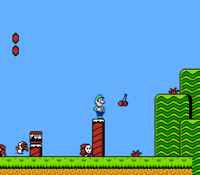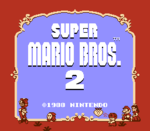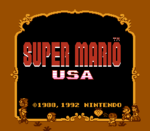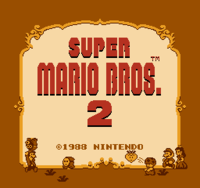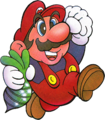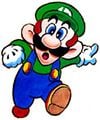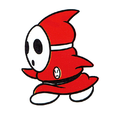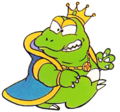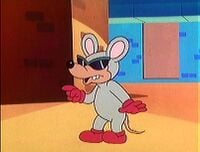Super Mario Bros. 2: Difference between revisions
(→Trivia) |
No edit summary |
||
| (993 intermediate revisions by more than 100 users not shown) | |||
| Line 1: | Line 1: | ||
{{italic title}} | {{italic title}} | ||
{{ | {{FA}} | ||
{{ | {{about|the {{wp|Western world|Western}} Super Mario Bros. 2|the original sequel to [[Super Mario Bros.]] also titled Super Mario Bros. 2|[[Super Mario Bros.: The Lost Levels]]|the Nintendo 3DS sequel to [[New Super Mario Bros.]]|[[New Super Mario Bros. 2]]}} | ||
{{ | {{redirect|SMB2|the power-up and its respective form in [[Super Mario Maker 2]]|[[SMB2 Mushroom]] and [[SMB2 Mario]]}} | ||
|image=[[File:SMB2 Boxart. | {{game infobox | ||
|image=[[File:SMB2 Boxart.png|230px]] | |||
|developer=[[Nintendo Entertainment Analysis and Development|Nintendo EAD]] | |developer=[[Nintendo Entertainment Analysis and Development|Nintendo EAD]] | ||
|publisher=[[Nintendo]] | |publisher=[[Nintendo]] | ||
| | |release='''NES/Famicom:'''<br>{{release|USA|September 1988<ref>{{cite|title=''Nintendo Power Pak Source''|page=20|publisher=Nintendo of America|language=en-us}}</ref> or October 1988<ref>{{cite|deadlink=y|archive=web.archive.org/web/20080921015524/http://www.nintendo.com/consumer/gameslist/manuals/nes_games.pdf|title=NES Games|format=PDF|publisher=Nintendo of America|language=en-us|accessdate=June 5, 2024}}</ref>|Europe|April 28, 1989|Australia|May 4, 1989<ref>{{cite|url=www.imdb.com/title/tt0204659/releaseinfo?ref_=tt_ov_inf|title=Super Mario Bros. 2 (Video Game 1988) - Release info|publisher=IMDb|language=en|accessdate=June 5, 2024}}{{better source}}</ref>|Japan|September 14, 1992<ref>{{cite|language=ja|publisher=[[Shogakukan]]|date=October 19, 2015|title=''Super Mario Bros. Hyakka: Nintendo Kōshiki Guidebook'', ''Super Mario USA'' section|page=64|isbn=978-4-09-106569-8}}</ref>}} '''Nintendo PlayChoice-10:'''<br>{{release|USA|1988}} '''Virtual Console (Wii):'''<br>{{release|Europe|May 25, 2007|Australia|May 25, 2007|USA|July 2, 2007|Japan|August 10, 2007<ref>{{cite|url=themushroomkingdom.net/games/smb2-vc|title=''Super Mario Bros. 2'' (VC)|publisher=The Mushroom Kingdom|accessdate=June 5, 2024}}</ref>|South Korea|July 17, 2008<ref name="korea">{{cite|deadlink=y|archive=web.archive.org/web/20081205120942/http://www.nintendo.co.kr/Wii/wii/vconsol.php|title=Wii|publisher=Nintendo Korea|language=ko|accessdate=June 5, 2024}}</ref>}}'''Virtual Console (3DS):'''<br>{{release|Japan|November 28, 2012<ref>{{cite|url=www.nintendo.co.jp/titles/50010000012209|title=スーパーマリオUSA|language=ja|publisher=Nintendo|accessdate=June 5, 2024}}</ref>|USA|July 11, 2013|Europe|August 7, 2013|Australia|August 8, 2013|South Korea|March 2, 2016}}'''Virtual Console (Wii U):'''<br>{{release|USA|May 16, 2013|Europe|May 16, 2013|Australia|May 16, 2013|Japan|March 19, 2014}}'''NES Classic Edition:'''<br>{{release|Japan|November 10, 2016|Australia|November 10, 2016|USA|November 11, 2016|Europe|November 11, 2016}}'''Nintendo Entertainment System - Nintendo Switch Online:'''<br>{{release|Japan|February 13, 2019<ref>{{cite|author=Nintendo|date=February 5, 2019|url=youtu.be/msV0JJR6Eu8|title=ファミリーコンピュータ Nintendo Switch Online 追加タイトル <nowiki>[2019年2月]</nowiki>|language=ja|publisher=YouTube|accessdate=June 5, 2024}}</ref>|USA|February 13, 2019<ref>{{cite|author=Nintendo of America|date=February 5, 2019|url=youtu.be/ZU6_I-6lPj8|title=Nintendo Entertainment System - February Game Updates - Nintendo Switch Online|publisher=YouTube|accessdate=June 5, 2024}}</ref>|Europe|February 13, 2019<ref>{{cite|lanugage=en-gb|url=x.com/NintendoEurope/status/1093147353735933953|title=#SuperMario Bros. 2 and #Kirby’s Adventure are coming to #NintendoSwitchOnline – Nintendo Entertainment System on 13/02! #NES|publisher=X|author=Nintendo of Europe|accessdate=June 5, 2024}}</ref>|Australia|February 13, 2019<ref>{{cite|publisher=X|url=x.com/NintendoAUNZ/status/1095616086979104773|title=New #NES games have been added to #NintendoSwitchOnline – Nintendo Entertainment System! Save the world of Subcon in #SuperMario Bros. 2, and use your enemies’ powers against them in #Kirby’s Adventure!|date=February 13, 2019|language=en-au|accessdate=June 5, 2024}}</ref>|HK|April 23, 2019|South Korea|April 23, 2019}} | ||
|languages={{languages|en_us=y}} | |||
|genre=2D | |genre=2D [[Genre#Platform games|platformer]] | ||
|modes=Single player | |modes=Single player | ||
|ratings={{ratings|acb= | |ratings={{ratings|acb=G|cero=A|esrb=E|pegi=3}} | ||
|platforms=[[ | |platforms=[[Family Computer]]/[[Nintendo Entertainment System]], [[Nintendo PlayChoice-10]], [[Virtual Console]] ([[Wii]], [[Nintendo 3DS]], [[Wii U]]), [[Classics#NES Classic Edition|NES Classic Edition]]/[[Classics#Nintendo Classic Mini: Family Computer|Nintendo Classic Mini: Family Computer]], [[Nintendo Entertainment System - Nintendo Switch Online]] | ||
| | |format={{format|nes=1|wiidl=1|3dsdl=1|wiiudl=1|nesclassic=1|switchdl=1}} | ||
| | |input={{input|nes=1|wmsideways=1|classic=1|wiigcn=1|3ds=1|wiiu=1|wiiusideways=1|wiiupro=1|wiiuclassic=1|nesclassic=1|joy-con=1|switchpro=1|switchnes=1}} | ||
|input={{input|nes=1|wmsideways=1|classic=1|wiigcn=1|3ds=1}} | |||
}} | }} | ||
'''''Super Mario Bros. 2''''' | '''''Super Mario Bros. 2''''' is the second game in the ''[[Super Mario (series)|Super Mario]]'' series outside Japan and the third entry overall.<ref name=encyclopedia>{{cite|author=Kazuya Sakai (Ambit), kikai, Akinori Sao, Junko Fukuda, Kunio Takayama, and Ko Nakahara ({{wp|Shogakukan}}) (ed.)|title=''[[Super Mario Bros. Encyclopedia|Encyclopedia Super Mario Bros.]]''|location=Milwaulkie|publisher=[[Dark Horse Comics|Dark Horse Books]]|date=2018|isbn=978-4-09-106569-8}}</ref> It is a 2D [[Genre#Platform games|platform game]] originally released for the [[Nintendo Entertainment System]] in North America in 1988. In the years that followed, it has been ported to many other systems, including a release on the [[Wii]]'s [[Virtual Console#Wii|Virtual Console]] in 2007, the [[Nintendo 3DS]]'s [[Virtual Console#Nintendo 3DS|Virtual Console]] in 2012, and the [[Wii U]]'s [[Virtual Console#Wii U|Virtual Console]] in 2013. As a result of Japan already having a ''Super Mario Bros. 2'' (known in English as ''[[Super Mario Bros.: The Lost Levels]]'' and ''[[Super Mario Bros. Deluxe#Super Mario Bros. for Super Players|Super Mario Bros. for Super Players]]''), the game did not make its debut in the country until after the release of ''[[Super Mario World]]'', on September 14, 1992, making it Japan's fifth installment of the series. | ||
''Super Mario Bros. 2'' | One of the central game mechanics that differentiates ''Super Mario Bros. 2'' from other ''Super Mario'' games is that players can select four characters—[[Mario]], [[Luigi]], [[Toad]], or [[Princess Peach|Princess Toadstool]]—and each of these characters has their unique gameplay mechanics, offering advantages and disadvantages in their stats. Another distinction is that players cannot defeat enemies by [[stomp]]ing on them; players need to either toss items at enemies or pick up and toss enemies at each other to defeat them. | ||
''Super Mario Bros. 2'' came about after [[Nintendo]] of America deemed ''Super Mario Bros.: The Lost Levels'' too difficult for {{wp|Western world|Western}} audiences,<ref>{{cite|author=McLaughlin, Rus|date=September 13, 2010|url=www.ign.com/articles/2010/09/14/ign-presents-the-history-of-super-mario-bros|title=IGN Presents: The History of ''Super Mario Bros.''|publisher=IGN|accessdate=June 5, 2024}}</ref> which led Nintendo to redevelop the [[Family Computer Disk System]] game ''[[Yume Kōjō: Doki Doki Panic]]'' into a ''Super Mario Bros.'' game for the international release. After its release, the game became a commercial success, and eventually the game became well received enough that it was also released in Japan. After performing well both critically and commercially, ''Super Mario Bros. 2'' has been rereleased as one of the four games featured in ''[[Super Mario All-Stars]]'', as well as having its own [[reissue|remake]] in ''[[Super Mario Advance]]''. Many enemies introduced in ''Super Mario Bros. 2'' have become common recurring enemies in the ''[[Super Mario (franchise)|Super Mario]]'' franchise, such as [[Bob-omb]]s, [[Pokey]]s, [[Shy Guy]]s, and more, while the gameplay mechanic of picking up various items and tossing them has been reused in several later games. | |||
==Story== | ==Story== | ||
'''Story from the instruction booklet''' | |||
<blockquote> | |||
One night, [[Mario]] had a strange dream. He found himself climbing a long staircase leading up to a mysterious door. Opening the door, Mario's eyes fell upon an incredible world unlike anything he'd ever seen. A quiet voice spoke to Mario, saying, | One night, [[Mario]] had a strange dream. He found himself climbing a long staircase leading up to a mysterious door. Opening the door, Mario's eyes fell upon an incredible world unlike anything he'd ever seen. A quiet voice spoke to Mario, saying, | ||
"Welcome to [[Subcon]], the land of dreams. Our once-beautiful world now suffers at the hands of the evil [[Wart]]. Please help us! Only you can free us from his tyranny. Oh, and remember one thing: Wart hates vegetables." | "Welcome to [[Subcon]], the land of dreams. Our once-beautiful world now suffers at the hands of the evil [[Wart]]. Please help us! Only you can free us from his tyranny. Oh, and remember one thing: Wart hates vegetables." | ||
However, before Mario could figure out what was happening, he suddenly awoke on his bed and realized that it was all a dream. The next day, while heading out to a picnic with his friends [[Luigi]], [[Princess Peach]], and [[Toad]], Mario told the tale of his strange dream. Hearing this was quite a shock to his friends, who all had the very same dream the night before. | However, before Mario could figure out what was happening, he suddenly awoke on his bed and realized that it was all a dream. The next day, while heading out to a picnic with his friends [[Luigi]], [[Princess Peach|Princess Toadstool]], and [[Toad]], Mario told the tale of his strange dream. Hearing this was quite a shock to his friends, who all had the very same dream the night before. | ||
Upon arriving at their picnic spot, the group noticed a small cave. Inside was a long staircase that led up to a door. At the top, the four friends opened the door and stood shocked by what they saw. It was Subcon - the world of their dreams! | Upon arriving at their picnic spot, the group noticed a small cave. Inside was a long staircase that led up to a door. At the top, the four friends opened the door and stood shocked by what they saw. It was Subcon - the world of their dreams! | ||
{{ | </blockquote> | ||
Mario discovers that Subcon has been taken over by Wart and that the events of his dream are true. Mario and co. are now on a quest to defeat Wart and restore peace to the dream world. At the end of the game, Mario, Luigi, Toadstool and Toad are seen being chanted on by the inhabitants of Subcon, who are carrying Wart across the room. Mario then wakes up and wonders about whether the events were true or just a dream. He then continues sleeping and the game ends. | |||
'''In-game story''' | |||
<blockquote> | |||
When Mario opened a door after climbing a long stair in his dream, another world spread before him and he heard a (faint)<ref>{{cite|url=themushroomkingdom.net/smb2_proto.shtml|title=''Super Mario Bros. 2'' Prototype|publisher=The Mushroom Kingdom|accessdate=June 5, 2024|language=en}}</ref> voice call for help to be freed from a spell. | |||
After awakening, Mario went to a cave nearby and to his surprise he saw exactly what he saw in his dream.... | |||
</blockquote> | |||
==Gameplay== | ==Gameplay== | ||
[[File: | [[File:Luigi SMB2.png|thumb|left|A screenshot from the Nintendo Entertainment System version of ''Super Mario Bros. 2''.]] | ||
Since the game is a reskin of ''[[Yume Kōjō: Doki Doki Panic]]'', it has little in common with the original ''[[Super Mario Bros.]]'' For example, in order to defeat enemies, the player needs to pluck clumps of [[grass]] to receive items (such as [[vegetable]]s), and then throw the vegetables at them. It is also possible to defeat enemies by jumping on them, picking them up and then throwing them to other enemies. There are a few elements in common with its predecessor, however, such as the appearances of the [[Mushroom]] and [[Super Star|Starman]], although the former has a different function. If the player has one health point remaining, they turn into their [[Small Mario|Small form]]. Additionally, there are no power-ups in the game that grant the player additional abilities in the [[Super Mario (form)|Super form]] such as the ability to shoot fireballs, making ''Super Mario Bros. 2'' one of the only 2D ''Super Mario'' titles (with the other being ''[[Super Mario Run]]'') to not have additional forms after the Super form. | |||
At the beginning of each level, the player can choose between the playable characters: Mario, Luigi, Toad and Princess Toadstool. All four characters | At the beginning of each level, the player can choose between the playable characters: Mario, Luigi, Toad, and Princess Toadstool. All four characters have different powers and statistics. When entering the next level, players can select a different character. | ||
At the end of most levels of the game, the player fights [[Birdo]]. The player has to jump on the [[Birdo's Egg|egg]]s that it spits, grab them and throw them back, hitting Birdo three times to gain a [[Crystal Ball|crystal]] which opens the Mask Gate at the end of the level. There are several colors of Birdos: pink, which only spits eggs; red, which spits eggs and fireballs and green, which only spits fireballs. For the green Birdos, there are [[Mushroom Block]]s nearby for the player to use instead. | |||
At the end of most levels of the game, the player fights [[Birdo]]. The player has to jump on the | |||
There are seven worlds in this game. The first six has three levels apiece, and the seventh has two. At the end of each world, the player encounters one | There are seven worlds in this game. The first six has three levels apiece, and the seventh has two. At the end of each world, the player encounters one boss. [[Mouser]] is encountered at the end of World 1, [[Tryclyde]] in World 2, Mouser again in World 3, [[Fryguy]] in World 4, [[Clawgrip]] in World 5, Tryclyde again in World 6, and Wart himself at the end of World 7. | ||
{{ | |||
Defeated enemies and Birdo can re-spawn if the player runs one screen away from the area where they normally appear and return, which may allow the player to defeat the enemies again in order to regain health if necessary; this still occurs in later releases (except ''Super Mario Advance''), but a defeated Birdo does not reappear unless the player completely leaves and re-enters the areas where Birdo is fought. | |||
===Controls=== | |||
{|class="wikitable"style="text-align:center" | |||
|- | |||
!Action(s) | |||
!NES | |||
!Wii Remote | |||
!Wii Classic Controller | |||
!GameCube Controller | |||
!Nintendo 3DS | |||
!Wii U GamePad / Pro Controller (Default) | |||
!Nintendo Switch Dual Joy-Con / Pro Controller (Default) | |||
!Nintendo Switch Single Joy-Con (Default) | |||
|- | |||
|Jump, accept | |||
|{{button|nes|A}} | |||
|{{button|wii|2}} | |||
|{{button|wii|cca}} or {{button|wii|ccx}} | |||
|{{button|gcn|A}} or {{button|gcn|X}} | |||
|{{button|3ds|A}} or {{button|3ds|X}} | |||
|{{button|wiiu|A}} or {{button|wiiu|X}} | |||
|{{button|switch|A}} or {{button|switch|X}} | |||
|{{button|switch|jc-right}} | |||
|- | |||
|Dash, pick up objects, throw objects, pluck vegetables, stop slots at the [[Bonus Chance]] | |||
|{{button|nes|B}} | |||
|{{button|wii|1}} | |||
|{{button|wii|ccb}} or {{button|wii|ccy}} | |||
|{{button|gcn|B}} or {{button|gcn|Y}} | |||
|{{button|3ds|B}} or {{button|3ds|Y}} | |||
|{{button|wiiu|B}} or {{button|wiiu|Y}} | |||
|{{button|switch|B}} or {{button|switch|Y}} | |||
|{{button|switch|jc-bottom}} or {{button|switch|jc-top}} | |||
|- | |||
|Pause the game, confirm menu option | |||
|{{button|nes|start}} | |||
|{{button|Wii|+}} | |||
|{{button|Wii|+}} | |||
|{{button|gcn|start}} | |||
|{{button|3ds|start}} | |||
|{{button|wiiu|Plus}} | |||
|{{button|switch|Plus}} | |||
|{{button|switch|PlusMinus}} + {{button|switch|SR}} | |||
|- | |||
|Select option after a [[Game Over]] | |||
|{{button|nes|select}} | |||
|{{button|wii|-}} | |||
|{{button|wii|-}} | |||
|{{button|gcn|Y}} | |||
|{{button|3ds|select}} | |||
|{{button|wiiu|Minus}} | |||
|{{button|switch|Minus}} | |||
|{{button|switch|PlusMinus}} + {{button|switch|SL}} | |||
|- | |||
|Select character, move character | |||
|{{button|nes|Pad}} (left/right) | |||
|{{button|wii|Padleftright}} | |||
|{{button|wii|Padleftright}} or {{button|wii|ccstickL}} (left/right) | |||
|{{button|gcn|Pad}} or {{button|gcn|Stick}} (left/right) | |||
|{{button|3ds|Padleftright}} or {{button|3ds|Stick}} (left/right) | |||
|{{button|wiiu|Padleftright}} or {{button|wiiu|Stick}} (left/right) | |||
|{{button|switch|leftstick}} (left/right) | |||
|{{button|switch|stick}} (left/right) | |||
|- | |||
|Enter doors and other openings, climb up vine | |||
|{{button|nes|Pad}} (up) | |||
|{{button|wii|Padup}} | |||
|{{button|wii|Padup}} or {{button|wii|ccstickL}} (up) | |||
|{{button|gcn|Pad}} or {{button|gcn|Stick}} (up) | |||
|{{button|3ds|Padup}} or {{button|3ds|Stick}} (up) | |||
|{{button|wiiu|Padup}} or {{button|wiiu|Stick}} (up) | |||
|{{button|switch|leftstick}} (up) | |||
|{{button|switch|stick}} (up) | |||
|- | |||
|[[Crouch]] ([[Crouching High Jump|Power Squat Jump]] if held long enough), enter [[jar]]s, climb down vines | |||
|{{button|nes|Pad}} (down) | |||
|{{button|wii|Paddown}} | |||
|{{button|wii|Paddown}} or {{button|wii|ccstickL}} (down) | |||
|{{button|gcn|Pad}} or {{button|gcn|Stick}} (down) | |||
|{{button|3ds|Paddown}} or {{button|3ds|Stick}} (down) | |||
|{{button|wiiu|Paddown}} or {{button|wiiu|Stick}} (down) | |||
|{{button|switch|leftstick}} (down) | |||
|{{button|switch|stick}} (down) | |||
|} | |||
==Characters== | ==Characters== | ||
===Playable characters=== | |||
===Playable=== | {|class=wikitable width=80% style="text-align:center" | ||
!width=20%|Character Name | |||
!width=20%|[[Mario]] | |||
!width=20%|[[Luigi]] | |||
!width=20%|[[Toad]] | |||
!width=20%|[[Princess Peach|Princess Toadstool]] | |||
|- | |||
!Artwork | |||
![[File:MarioSMB2NES2.png|110px]] | |||
![[File:LuigiSMB2NES.png|120px]] | |||
![[File:ToadSMB2NES2.png|90px]] | |||
![[File:SMUSA Peach Running Artwork.png|120px]] | |||
|- | |||
!Speed | |||
|★★★★☆ | |||
|★★★☆☆ | |||
|★★★★★ | |||
|★★☆☆☆ | |||
|- | |||
!Jump | |||
|★★★★☆ | |||
|★★★★★ | |||
|★★☆☆☆ | |||
|★★★☆☆ | |||
|- | |||
!Strength | |||
|★★★★☆ | |||
|★★★☆☆ | |||
|★★★★★ | |||
|★★☆☆☆ | |||
|- | |||
!Description | |||
|align="left"|Mario has average stats, making him an acceptable choice in all situations. He has no outstanding abilities. | |||
|align="left"|Luigi has a high jump, but he is weaker than average. He is slightly slower than average as well. | |||
|align="left"|Toad is the fastest and the strongest. He has the lowest jump in the game, however. Due to his poor jumping ability, he relies heavily on the charged jump. | |||
|align="left"|The princess has a special float jump that allows her to hover in midair, which can be used to jump further or correct an otherwise fatal landing. As a tradeoff, she has the lowest speed and power. | |||
|} | |||
===Supporting=== | ===Supporting characters=== | ||
{|class=wikitable width=80% | |||
|- | |||
!Image | |||
!Description | |||
|- | |||
|align="center"|[[Subcon (species)|Subcon]]<br>[[File:Subcon SMB2 sprite.png]] | |||
|The Subcon species are a group of peaceful fairy-like beings that have their land invaded by Wart. Wart traps them in jars, and they plead Mario and his friends for help. They also give Mario and his friends vital information to defeat Wart (namely that Wart hates vegetables). | |||
|- | |||
|align="center"|{{nw|[[Mask Gate]]}}<br>[[File:SMB2 Mask Gate sprite.png]][[File:SMB2 Mask Gate sprite 2.png]] | |||
|Found at the end of each level (or, in boss levels, just before the boss room), Mask Gates will open once the level's Crystal Ball (which is either dropped by Birdo or found out in the open) has been picked up. When entered, the level ends (or, in boss levels, the boss room is entered). | |||
|} | |||
===Enemies=== | ===Enemies=== | ||
{| | {|class=wikitable width=80% | ||
|- | |||
!Image | |||
!Description | |||
|- | |- | ||
| | |align="center"|[[Albatoss]]<br>[[File:Albatoss SMB2 Sprite.png]] | ||
|Albatosses fly only horizontally. They can drop Bob-Ombs on players, but they can also be ridden. Unlike other enemies, they cannot be picked up, but they are defeated as with any other enemy. | |||
|- | |||
|align="center"|[[Autobomb]]<br>[[File:Autobomb SMB2 Sprite.png]] | |||
|Shyguys often ride Autobombs. Autobombs shoot projectiles, but if the Shyguy is removed, they simply move. Players can ride on Autobombs, but Autobombs must be destroyed with an item. | |||
|- | |||
| | |align="center"|[[Beezo]]<br>[[File:SMB2 Red Beezo Sprite.png]] | ||
|Beezos fly down and attempt to run into the player with their bidents. Players can jump on them and pick them up. | |||
|- | |||
|align="center"|[[Bob-omb|Bob-Omb]]<br>[[File:Original Bomb.png]] | |||
|Bob-Ombs run back and forth and eventually self-destruct if they are near a player. If they self-destruct, they can harm players. Players can pick them up and throw them. | |||
|- | |||
| | |align="center"|[[Cobrat]]<br>[[File:Cobrat SMB2 Sprite.png]] | ||
|Cobrats are seen roaming on the ground, but they can also hide in jars. If they spot a player, they may jump and shoot a single projectile. Cobrats can be picked up and thrown. | |||
|- | |||
|align="center"|[[Flurry]]<br>[[File:Flurry SMB2 Sprite.png]] | |||
|Flurries are found only in ice levels. Here, they attempt to run into the player. They move faster than average, but they are prone to slipping. | |||
|- | |||
| | |align="center"|[[Hoopster]]<br>[[File:Hoopster SMB2 Sprite.png]] | ||
|Hoopsters crawl slowly on vines or trees aimlessly, occasionally speeding up whenever descending. They harm players if they make contact with them from above or the side. Players can jump on and ride them like an elevator, and even pick them up and throw them. | |||
|- | |||
|align="center"|[[Ninji]]<br>[[File:Ninji SMB2 Sprite.png]] | |||
|Some Ninjis are stationary enemies that simply jump while others charge and jump into the player. They can be picked up and thrown. | |||
|- | |||
|align="center"|[[Ostro]]<br>[[File:Ostro SMB2 Sprite.png]] | |||
|Ostros are often seen being ridden by Shyguys. If the Shyguy is removed, they travel in a straight line. They can be picked up and thrown, but they do not bounce off enemies. | |||
|- | |||
|align="center"|[[Panser]]<br>[[File:Panser SMB2 Sprite.png]] | |||
|Pansers shoot fireballs at the player. Red varieties are stationary and shoot three fireballs. The green/gray variety patrols and shoot fireballs straight up. Pink varieties chase the player and shoot three fireballs. | |||
|- | |||
|align="center"|[[Phanto]]<br>[[File:Madmask.png]] | |||
|Phantos are normally dormant enemies, but if players pick up a key, they attempt to fly into the player. If the player drops or uses the key, they deactivate. They cannot be picked up and there are limited methods to destroy them. | |||
|- | |||
|align="center"|[[Pidgit]]<br>[[File:Pidgit SMB2 Sprite.png]] | |||
|Pidgits are always seen on carpets. Pidgits attempt to dive bomb into the player, but players can jump on them, pick them up, and throw them. Once the Pidgit has been removed, players can ride the carpet and control it for a brief amount of time. | |||
|- | |||
|align="center"|[[Pokey]]<br>[[File:Pokey SMB2 Sprite.png]] | |||
|Pokeys attack players by moving slowly into them. Pokeys can be various heights. They can be defeated by having objects thrown at them or their body segments being removed one by one. | |||
|- | |||
|align="center"|[[Porcupo]]<br>[[File:Porcupo SMB2 Sprite.png]] | |||
|Porcupos cannot be jumped on, so to defeat them, players must throw an object at them. | |||
|- | |||
|align="center"|[[Shy Guy|Shyguy]]<br>[[File:SMB2 Red Shyguy Sprite.png]] | |||
|The basic enemies of the game, Shyguys walk back and forth, harming the player if they run into them. They can be picked up and thrown. Red Shyguys walk off cliffs while pink Shyguys turn at the ledges. | |||
|- | |||
|align="center"|[[Small Fry Guy]]<br>[[File:Small Fry Guy NES.png]] | |||
|Small versions of Fryguy that bounce in the player's direction. They appear when Fryguy is defeated. They cannot be picked up or thrown, and must have an item thrown at them to be defeated. | |||
|- | |||
|align="center"|[[Snifit]]<br>[[File:Snifit SMB2.png]][[File:Snifit SMB2 Sprite.png]] | |||
|Snifits shoot projectiles at players, but they act similar to Shyguys. Gray/green Snifits jump and fire projectiles while the other variants walk. The pink Snifit turns around at ledges while a singular red Snifit in [[World 3-3 (Super Mario Bros. 2)|World 3-3]] walks off ledges. | |||
|- | |||
|align="center"|[[Spark]]<br>[[File:Spark SMB2 Sprite.png]] | |||
|Sparks circle around platforms or hover in the air. Sparks can harm the player if they touch them. | |||
|- | |||
|align="center"|[[Trouter]]<br>[[File:Trouter SMB2 Sprite.png]] | |||
|Trouters jump from below and fall back. Players can use them as platforms to jump across gaps, but Trouters can harm players if players touch them at the sides. | |||
|- | |||
|align="center"|[[Tweeter]]<br>[[File:Tweeter.png]] | |||
|Tweeters, although they have wings, are found hopping across the ground. They can be picked up and thrown. | |||
|- | |||
|align="center"|[[Whale]]<br>[[File:Whale SMB2 Sprite.png]] | |||
|Not typical enemies, whales serve generally as platforms. Their bodies and their tails can be jumped on. Their waterspouts can also carry players, but the waterspouts can harm players if players touch them at the sides. | |||
|} | |||
====Mini-bosses==== | |||
{|class=wikitable width=80% | |||
|- | |||
!Image | |||
!Description | |||
|- | |||
|align="center"|[[Birdo]]<br>[[File:SMB2BirdoSprite.png]][[File:Birdo Red SMB2 Sprite.png]]<br>[[File:Birdo Gray SMB2 Sprite.png]][[File:Birdo Green SMB2 Sprite.png]] | |||
|Birdo is a recurring mini-boss, appearing at the end of every first and second level in the worlds. Birdo comes in three varieties. The pink one shoots simply eggs, which can be picked up and thrown at it. The red one shoots randomly eggs or fireballs (which harms players if they touch them). The remaining type appears green or gray depending on location (but are assigned to the same palette) and shoots only fireballs; these ones must be defeated with [[Mushroom Block]]s. | |||
|} | |} | ||
====Bosses==== | ====Bosses==== | ||
{| | {|class=wikitable width=80% | ||
|- | |||
!Image | |||
!Description | |||
|- | |||
|align="center"|[[Mouser]]<br>[[File:SMB2 Gray Mouser Sprite.png]][[File:Mouser Green NES.png]] | |||
|Mouser is the first true boss players encounter. He attacks by throwing bombs. The bombs sit for a while before they explode, enabling players to pick them up and throw them at Mouser. If the bomb explodes on Mouser, he takes damage. There are two variants of Mouser: one with pink ears and one with green ears. A {{file link|DDP Albino Mouser.png|white and red variant}} was replaced by Clawgrip when ''Yume Kōjō: Doki Doki Panic'' was remade into ''Super Mario Bros. 2''. | |||
|- | |||
|align="center"|[[Tryclyde]]<br>[[File:Tryclyde SMB2 NES sprite.png]] | |||
|Tryclyde shoots a series of fireballs that harms the player if the player touches them. Players must throw several Mushroom Blocks at Tryclyde to defeat him. | |||
|- | |||
|align="center"|[[Fryguy]]<br>[[File:Fryguy SMB2 Sprite.png]] | |||
|Fryguy shoots fireballs at players. Players must throw Mushroom Blocks at him to damage him. Once he takes enough damage, he bursts into [[Small Fry Guy]]s. These take one hit from a Mushroom Block to be defeated, and destroying these enemies clears the level. | |||
|- | |||
|align="center"|[[Clawgrip]]<br>[[File:Clawgrip SMB2 Sprite.png]] | |||
|Clawgrip throws rocks at players. These rocks can be picked up and tossed at Clawgrip, inflicting damage on him. Once he is hit five times, he is defeated. | |||
|- | |||
|align="center"|{{nw|[[Mask Gate]]}}<br>[[File:SMB2 Mask Gate sprite 3.png]] | |||
|Although most Mask Gates are harmless and allow completion to the level, the Mask Gate within the dream factory is aggressive, attacking the players by flying into them. Players must attack it with [[Mushroom Block]]s to stun it for a short period. Once it is stunned, it allows entry into Wart's room. | |||
|- | |- | ||
| | |align="center"|[[Wart]]<br>[[File:Wart SMB2 Sprite.png]] | ||
|Wart is the final boss of the game. He moves back and forth and shoots harmful bubbles at the player. A [[Dream Machine|machine]] nearby spawns vegetables. To defeat Wart, players must throw these vegetables at Wart when Wart's mouth is open. Wart takes six hits to defeat. | |||
| | |||
|} | |} | ||
=== | ==Items and objects== | ||
{|class=wikitable width=80% | |||
|- | |||
!Image | |||
!Description | |||
|- | |||
|align="center"|[[1-Up Mushroom|1 UP]]<br>[[File:SMB2 1-Up Mushroom Sprite.png]] | |||
|When players collect this item, they receive an extra life. | |||
|- | |||
|align="center"|[[Beanstalk]], [[Chain (object)|Chain]], and [[Ladder]]<br>[[File:Super Mario Bros 2 Beanstalk.png]][[File:Super Mario Bros 2 Chain.png]][[File:Super Mario Bros 2 Ladder.png]] | |||
|Can be climbed to safely reach higher or lower locations. | |||
|- | |||
|align="center"|[[Bomb]]<br>[[File:Bomb SMB2 Sprite.png]] | |||
|Bombs can be found normally, from plucking vegetables, or from Mouser. They eventually explode, destroying [[brick wall]]s as well as harming nearby enemies and players. | |||
|- | |||
|align="center"|[[Brick wall]]<br>[[File:Brick wall SMB2 NES.png]] | |||
|Brick walls can be destroyed by explosions created by bombs and [[Bob-omb]]s, which is often necessary to progress. | |||
|- | |||
|align="center"|[[Cherry]]<br>[[File:SMB2 Cherry Sprite.png]] | |||
|Found scattered throughout levels, cherries can be collected. If players collect five, a [[Super Star|Starman]] appears. | |||
|- | |||
|align="center"|[[Coin]]<br>[[File:CoinSMB2.png]] | |||
|Coins are found only in [[Subspace|Sub-space]]. When players pluck vegetables, they receive coins. Coins are used in the [[Bonus Chance]] at the end of a level for extra lives. | |||
|- | |||
|align="center"|[[Crystal Ball]]<br>[[File:Crystal Ball SMB2 Sprite.png]] | |||
|Found at the end of the level or by defeating Birdo, Crystal Balls enable the Mask Gate to open so players can complete the level. | |||
|- | |||
|align="center"|[[Dream Machine]]<br>[[File:Dream_Machine_SMB2_sprite.png]] | |||
|A machine belonging to the Subcons, which produces the dreams that form the land of Subcon itself. In stealing it, Wart is able to force it into producing minions for his cause. During the battle with Wart, it creates Vegetables, Wart's weakness, for the player to use against him. | |||
|- | |||
|align="center"|[[Birdo's Egg|Egg]]<br>[[File:Birdo Egg SMB2 Sprite.png]] | |||
|Pink Birdos always spit out eggs, while Red Birdos sometimes spit out eggs (and sometimes spit out fireballs instead). Players can pick these eggs up as they travel through the air, then throw them at Birdo to inflict damage on it. | |||
|- | |||
|align="center"|[[Magic carpet|Flying carpet]]<br>[[File:Magic Carpet SMB2 Sprite.png]] | |||
|After Pidgits are defeated, players can ride and control their Magic Carpets for a short time. | |||
|- | |||
|align="center"|[[Grass]]<br>[[File:SMB2 Red Grass Tuft.png]] | |||
|The player can pull tufts of grass to reveal objects, mainly vegetables. | |||
|- | |||
|align="center"|[[Jar]]<br>[[File:Vase SMB2 Sprite.png]] | |||
|Jars, as with [[Warp Pipe]]s, can be entered by ducking. Jars contain usually some items, including POWs, Turtle Shells, and keys. Jars also contain some enemies, such as Shyguys. | |||
|- | |||
|align="center"|[[Key]]<br>[[File:Key SMB2 Sprite.png]] | |||
|Keys open locked doors, granting access to another part of the level. Phantos guard it, however. | |||
|- | |||
|align="center"|[[Magical Potion|Magic Potion]]<br>[[File:Magic Potion SMB2 Sprite.png]] | |||
|Found after being plucked, a Magic Potion creates a door depending where the player tosses them. This door leads to Sub-space. | |||
|- | |||
|align="center"|[[Mushroom]]<br>[[File:Mushroom smb2.png]] | |||
|Found only in certain spots of Sub-space, Mushrooms give an extra vitality point once they are picked up. This vitality remains for the rest of the level. The Mushroom also restores any lost health. | |||
|- | |||
|align="center"|[[Mushroom Block]]<br>[[File:MushroomBlock1.png]][[File:MushroomBlock2.png]][[File:MushroomBlock3.png]]<br>[[File:MushroomBlock4.png]][[File:MushroomBlock5.png]] | |||
|Mushroom Blocks are simple throwing items. They can be used as weapons or get stacked so players can reach higher places. Mushroom Block designs vary from world to world; the first design is used in Worlds 1 and 3 in all versions (and World 5 in the SNES and GBA versions), the second design is used in Worlds 2 and 6, the third design is used in World 4, the fourth design is used in World 5 exclusively in the NES version, and the fifth design is used in World 7. | |||
|- | |||
|align="center"|[[POW Block|POW]]<br>[[File:POW Block SMB2 Sprite.png]] | |||
|POWs can be thrown to create a powerful quake. This quake defeats most enemies in the screen. | |||
|- | |||
|align="center"|[[Rocket]]<br>[[File:Rocket SMB2 Sprite.png]] | |||
|Rockets are found in grass. If a rocket is found, it automatically transports players to the next part of the level. | |||
|- | |||
|align="center"|[[Small heart]]<br>[[File:Small Heart SMB2 Sprite.png]] | |||
|For every eight enemies defeated, a small heart appears. Small hearts restore any HP a player has lost. If the player is in [[Small Mario|small form]], the heart grows the player to [[Super Mario (form)|Super form]]. | |||
|- | |||
|align="center"|[[Super Star|Starman]]<br>[[File:Starman SMB2 Sprite.png]] | |||
|A Starman appears after players collect five cherries. Once players have collected a Starman, they become invincible for a short amount of time, enabling them to defeat most enemies that they touch. | |||
|- | |||
|align="center"|[[Stop Watch]]<br>[[File:Stopwatch SMB2 Sprite.png]] | |||
|Found by plucking four vegetables from the grass, then plucking what would otherwise be a fifth, the Stop Watch stops all enemy movements for a brief time. | |||
|- | |||
|align="center"|[[Red Shell|Turtle Shell]]<br>[[File:Red Shell SMB2 Sprite.png]] | |||
|Turtle Shells are found in grass. Once they are thrown, they slide across the ground, defeating any enemy it touches. Once it hits a wall, it is destroyed. If players attempt to land on the shell, they can ride on it. | |||
|- | |||
|align="center"|[[Vegetable]]<br>[[File:SMB2 Sprout 1.png]][[File:SMB2 Sprout 2.png]][[File:SMB2 Sprout 3.png]][[File:SMB2 Sprout 4.png]][[File:SMB2 Veggie 1.png]][[File:SMB2 Veggie 2.png]][[File:SMB2 Veggie 3.png]][[File:SMB2 Veggie 4.png]][[File:SMB2 Veggie 5.png]][[File:SMB2 Veggie 6.png]] | |||
|The basic weapon in the game, vegetables are plucked from grass tufts and can be thrown at enemies to defeat them. Vegetables bounce after they hit an enemy, which can lead to consecutive hits on enemies. If one vegetable defeats enough enemies, extra lives may be rewarded. While unripened vegetables (Sprouts) have no additional effects, plucking four fully ripened vegetables, then going to pluck a fifth, will instead result in the player plucking a Stop Watch. | |||
|} | |||
== | ==Worlds and levels== | ||
{| | Enemies that make their first level appearance are marked with an asterisk. | ||
{|class=wikitable | |||
|- | |- | ||
!World | !World | ||
!Terrain | !Terrain | ||
!Level | !Level | ||
!Enemies found | !Enemies found | ||
|- | |- | ||
|rowspan=3|[[World 1 (Super Mario Bros. 2)|World 1]] | |rowspan=3|[[World 1 (Super Mario Bros. 2)|World 1]] | ||
|rowspan=3|Grass | |rowspan=3|[[File:SMB2 Semisolid Platform Screenshot.png]]<br><center>Grass</center> | ||
|1 | |[[World 1-1 (Super Mario Bros. 2)|1]] | ||
| | |align="center"|[[File:SMB2 Red Shyguy Sprite.png|link=Shy Guy]]* [[File:Tweeter.png|link=Tweeter]]* [[File:Ninji SMB2 Sprite.png|link=Ninji]]* [[File:Hoopster SMB2 Sprite.png|link=Hoopster]]*<br> [[File:SMB2BirdoSprite.png|link=Birdo]]* | ||
|- | |- | ||
|2 | |[[World 1-2 (Super Mario Bros. 2)|2]] | ||
| | |align="center"|[[File:Pidgit SMB2 Sprite.png|link=Pidgit]]* [[File:SMB2 Red Beezo Sprite.png|link=Beezo]]* [[File:Madmask.png|link=Phanto]]* [[File:Ninji SMB2 Sprite.png|link=Ninji]] [[File:SMB2 Red Shyguy Sprite.png|link=Shy Guy]] [[File:Snifit SMB2 Sprite.png|link=Snifit]]* <br>[[File:SMB2BirdoSprite.png|link=Birdo]] | ||
|- | |- | ||
|3 | |[[World 1-3 (Super Mario Bros. 2)|3]] | ||
|Snifit | |align="center"|[[File:Snifit SMB2 Sprite.png|link=Snifit]] [[File:SMB2 Red Shyguy Sprite.png|link=Shy Guy]] [[File:Trouter SMB2 Sprite.png|link=Trouter]]* [[File:Ninji SMB2 Sprite.png|link=Ninji]] [[File:Spark SMB2 Sprite.png|link=Spark]]* [[File:Madmask.png|link=Phanto]] [[File:Tweeter.png|link=Tweeter]]<br>[[File:SMB2 Gray Mouser Sprite.png|link=Mouser]]* | ||
|- | |- | ||
|rowspan=3|[[World 2 (Super Mario Bros. 2)|World 2]] | |rowspan=3|[[World 2 (Super Mario Bros. 2)|World 2]] | ||
|rowspan=3|Desert | |rowspan=3|[[File:SMB2 W2-1 Screenshot.png]]<br><center>Desert</center> | ||
|1 | |[[World 2-1 (Super Mario Bros. 2)|1]] | ||
| | |align="center"|[[File:Cobrat SMB2 Sprite.png|link=Cobrat]]* [[File:Snifit SMB2 Sprite.png|link=Snifit]] [[File:SMB2 Red Shyguy Sprite.png|link=Shy Guy]] [[File:Panser SMB2 Sprite.png|link=Panser]]*<br>[[File:SMB2BirdoSprite.png|link=Birdo]] | ||
|- | |- | ||
|2 | |[[World 2-2 (Super Mario Bros. 2)|2]] | ||
|Cobrat | |align="center"|[[File:Cobrat SMB2 Sprite.png|link=Cobrat]] [[File:SMB2 Red Beezo Sprite.png|link=Beezo]] [[File:SMB2 Red Shyguy Sprite.png|link=Shy Guy]] [[File:Pokey SMB2 Sprite.png|link=Pokey]]* [[File:Panser SMB2 Sprite.png|link=Panser]] [[File:Ninji SMB2 Sprite.png|link=Ninji]] [[File:Snifit SMB2 Sprite.png|link=Snifit]]<br> [[File:Birdo Red SMB2 Sprite.png|link=Birdo]]* | ||
|- | |- | ||
|3 | |[[World 2-3 (Super Mario Bros. 2)|3]] | ||
|Shy Guy | |align="center"|[[File:SMB2 Red Shyguy Sprite.png|link=Shy Guy]] [[File:SMB2 Red Beezo Sprite.png|link=Beezo]] [[File:Cobrat SMB2 Sprite.png|link=Cobrat]] [[File:Pokey SMB2 Sprite.png|link=Pokey]] [[File:Tweeter.png|link=Tweeter]] [[File:Madmask.png|link=Phanto]] [[File:Spark SMB2 Sprite.png|link=Spark]] [[File:Panser SMB2 Sprite.png|link=Panser]] <br>[[File:Tryclyde SMB2 NES sprite.png|link=Tryclyde]]* | ||
|- | |- | ||
|rowspan=3|[[World 3 (Super Mario Bros. 2)|World 3]] | |rowspan=3|[[World 3 (Super Mario Bros. 2)|World 3]] | ||
|rowspan=3| | |rowspan=3|[[File:Supmario2-40.png]]<br><center>Waterfall/Caves</center> | ||
|1 | |[[World 3-1 (Super Mario Bros. 2)|1]] | ||
|Shy Guy | |align="center"|[[File:SMB2 Red Shyguy Sprite.png|link=Shy Guy]] [[File:Pidgit SMB2 Sprite.png|link=Pidgit]] [[File:SMB2 Red Beezo Sprite.png|link=Beezo]] [[File:Panser SMB2 Sprite.png|link=Panser]]<br> [[File:Birdo Red SMB2 Sprite.png|link=Birdo]] | ||
|- | |- | ||
|2 | |[[World 3-2 (Super Mario Bros. 2)|2]] | ||
|Shy Guy | |align="center"|[[File:SMB2 Red Shyguy Sprite.png|link=Shy Guy]] [[File:Ostro SMB2 Sprite.png|link=Ostro]]* [[File:SMB2 Red Beezo Sprite.png|link=Beezo]] [[File:Tweeter.png|link=Tweeter]] [[File:Porcupo SMB2 Sprite.png|link=Porcupo]]*<br>[[File:Birdo Red SMB2 Sprite.png|link=Birdo]] | ||
|- | |- | ||
|3 | |[[World 3-3 (Super Mario Bros. 2)|3]] | ||
| | |align="center"|[[File:Albatoss SMB2 Sprite.png|link=Albatoss]]* [[File:Original Bomb.png|link=Bob-omb]]* [[File:SMB2 Red Shyguy Sprite.png|link=Shy Guy]] [[File:Ostro SMB2 Sprite.png|link=Ostro]] [[File:Ninji SMB2 Sprite.png|link=Ninji]] [[File:Spark SMB2 Sprite.png|link=Spark]] [[File:Snifit SMB2 Sprite.png|link=Snifit]] [[File:Madmask.png|link=Phanto]] [[File:Tweeter.png|link=Tweeter]] [[File:Panser SMB2 Sprite.png|link=Panser]]<br>[[File:Mouser_Green_NES.png|link=Mouser]]* | ||
|- | |- | ||
|rowspan=3|[[World 4 (Super Mario Bros. 2)|World 4]] | |rowspan=3|[[World 4 (Super Mario Bros. 2)|World 4]] | ||
|rowspan=3|Ice / Snow | |rowspan=3|[[File:World 4-1 SMB2.png]]<br><center>Ice/Snow</center> | ||
|1 | |[[World 4-1 (Super Mario Bros. 2)|1]] | ||
| | |align="center"|[[File:Flurry SMB2 Sprite.png|link=Flurry]]* [[File:Trouter SMB2 Sprite.png|link=Trouter]] [[File:SMB2 Red Shyguy Sprite.png|link=Shy Guy]] [[File:Autobomb SMB2 Sprite.png|link=Autobomb]]* | ||
|- | |- | ||
|2 | |[[World 4-2 (Super Mario Bros. 2)|2]] | ||
|Beezo | |align="center"|[[File:SMB2 Red Beezo Sprite.png|link=Beezo]] [[File:Flurry SMB2 Sprite.png|link=Flurry]] [[File:Snifit SMB2 Sprite.png|link=Snifit]] [[File:SMB2 Red Shyguy Sprite.png|link=Shy Guy]] [[File:Autobomb SMB2 Sprite.png|link=Autobomb]] [[File:Porcupo SMB2 Sprite.png|link=Porcupo]]<br>[[File:Birdo Red SMB2 Sprite.png|link=Birdo]] | ||
|- | |- | ||
|3 | |[[World 4-3 (Super Mario Bros. 2)|3]] | ||
| | |align="center"|[[File:SMB2BirdoSprite.png|link=Birdo]] [[File:Flurry SMB2 Sprite.png|link=Flurry]] [[File:SMB2 Red Shyguy Sprite.png|link=Shy Guy]] [[File:Madmask.png|link=Phanto]] [[File:SMB2 Red Beezo Sprite.png|link=Beezo]]<br> [[File:Fryguy SMB2 Sprite.png|link=Fryguy]]* [[File:Mini Fryguy SMB2 Sprite.png|link=Small Fry Guy]]* | ||
|- | |- | ||
|rowspan=3|[[World 5 (Super Mario Bros. 2)|World 5]] | |rowspan=3|[[World 5 (Super Mario Bros. 2)|World 5]] | ||
|rowspan=3| | |rowspan=3|[[File:SMB2 World 5-1 Screenshot.png]]<br><center>Night</center> | ||
|1 | |[[World 5-1 (Super Mario Bros. 2)|1]] | ||
|Shy Guy | |align="center"|[[File:SMB2 Red Shyguy Sprite.png|link=Shy Guy]] [[File:Ostro SMB2 Sprite.png|link=Ostro]] [[File:Panser SMB2 Sprite.png|link=Panser]] [[File:Trouter SMB2 Sprite.png|link=Trouter]] <br>[[File:Birdo Gray SMB2 Sprite.png|link=Birdo]]* | ||
|- | |- | ||
|2 | |[[World 5-2 (Super Mario Bros. 2)|2]] | ||
|Bob-omb | |align="center"|[[File:Original Bomb.png|link=Bob-omb]] [[File:Hoopster SMB2 Sprite.png|link=Hoopster]] [[File:SMB2 Red Shyguy Sprite.png|link=Shy Guy]] [[File:Ostro SMB2 Sprite.png|link=Ostro]] [[File:Porcupo SMB2 Sprite.png|link=Porcupo]] [[File:Panser SMB2 Sprite.png|link=Panser]] [[File:Ninji SMB2 Sprite.png|link=Ninji]] [[File:SMB2 Red Beezo Sprite.png|link=Beezo]] [[File:Snifit SMB2 Sprite.png|link=Snifit]] [[File:Trouter SMB2 Sprite.png|link=Trouter]]<br>[[File:Birdo Red SMB2 Sprite.png|link=Birdo]] | ||
|- | |- | ||
|3 | |[[World 5-3 (Super Mario Bros. 2)|3]] | ||
|Albatoss | |align="center"|[[File:Albatoss SMB2 Sprite.png|link=Albatoss]] [[File:Original Bomb.png|link=Bob-omb]] [[File:Panser SMB2 Sprite.png|link=Panser]] [[File:Spark SMB2 Sprite.png|link=Spark]] [[File:SMB2 Red Shyguy Sprite.png|link=Shy Guy]] [[File:Snifit SMB2 Sprite.png|link=Snifit]] [[File:Pidgit SMB2 Sprite.png|link=Pidgit]] [[File:SMB2 Red Beezo Sprite.png|link=Beezo]]<br>[[File:Birdo Red SMB2 Sprite.png|link=Birdo]]<br>[[File:Clawgrip SMB2 Sprite.png|link=Clawgrip]]* | ||
|- | |- | ||
|rowspan=3|[[World 6 (Super Mario Bros. 2)|World 6]] | |rowspan=3|[[World 6 (Super Mario Bros. 2)|World 6]] | ||
|rowspan=3|Desert | |rowspan=3|[[File:SMB2 World 6-1 Cobrats.png]]<br><center>Desert</center> | ||
|1 | |[[World 6-1 (Super Mario Bros. 2)|1]] | ||
|Cobrat | |align="center"|[[File:Cobrat SMB2 Sprite.png|link=Cobrat]] [[File:SMB2 Red Shyguy Sprite.png|link=Shy Guy]] [[File:Pokey SMB2 Sprite.png|link=Pokey]] [[File:Panser SMB2 Sprite.png|link=Panser]] [[File:Madmask.png|link=Phanto]]<br>[[File:Birdo Green SMB2 Sprite.png|link=Birdo]] | ||
|- | |- | ||
|2 | |[[World 6-2 (Super Mario Bros. 2)|2]] | ||
|Albatoss | |align="center"|[[File:Albatoss SMB2 Sprite.png|link=Albatoss]] [[File:Panser SMB2 Sprite.png|link=Panser]] [[File:SMB2 Red Beezo Sprite.png|link=Beezo]]<br>[[File:Birdo Green SMB2 Sprite.png|link=Birdo]] | ||
|- | |- | ||
|3 | |[[World 6-3 (Super Mario Bros. 2)|3]] | ||
|Shy Guy | |align="center"|[[File:SMB2 Red Shyguy Sprite.png|link=Shy Guy]] [[File:Pokey SMB2 Sprite.png|link=Pokey]] [[File:Cobrat SMB2 Sprite.png|link=Cobrat]] [[File:Original Bomb.png|link=Bob-omb]] [[File:Ninji SMB2 Sprite.png|link=Ninji]] [[File:Hoopster SMB2 Sprite.png|link=Hoopster]] [[File:Snifit SMB2 Sprite.png|link=Snifit]]<br>[[File:Birdo Red SMB2 Sprite.png|link=Birdo]] [[File:Tryclyde SMB2 NES sprite.png|link=Tryclyde]] | ||
|- | |- | ||
|rowspan=2|[[World 7 (Super Mario Bros. 2)|World 7]] | |rowspan=2|[[World 7 (Super Mario Bros. 2)|World 7]] | ||
|rowspan=2| | |rowspan=2|[[File:SMB2 World 7-1 Start.png]]<br><center>Sky</center> | ||
|1 | |[[World 7-1 (Super Mario Bros. 2)|1]] | ||
|Albatoss | |align="center"|[[File:Albatoss SMB2 Sprite.png|link=Albatoss]] [[File:Original Bomb.png|link=Bob-omb]] [[File:Ninji SMB2 Sprite.png|link=Ninji]] [[File:SMB2 Red Shyguy Sprite.png|link=Shy Guy]] [[File:Spark SMB2 Sprite.png|link=Spark]] [[File:Tweeter.png|link=Tweeter]] [[File:Snifit SMB2 Sprite.png|link=Snifit]] [[File:Hoopster SMB2 Sprite.png|link=Hoopster]]<br>[[File:Birdo Gray SMB2 Sprite.png|link=Birdo]] | ||
|- | |- | ||
|2 | |[[World 7-2 (Super Mario Bros. 2)|2]] | ||
|Snifit | |align="center"|[[File:Snifit SMB2 Sprite.png|link=Snifit]] [[File:Ninji SMB2 Sprite.png|link=Ninji]] [[File:SMB2 Red Shyguy Sprite.png|link=Shy Guy]] [[File:Original Bomb.png|link=Bob-omb]] [[File:Panser SMB2 Sprite.png|link=Panser]] [[File:Spark SMB2 Sprite.png|link=Spark]] [[File:Tweeter.png|link=Tweeter]] [[File:Birdo Red SMB2 Sprite.png|link=Birdo]] [[File:Madmask.png|link=Phanto]] <br>[[File:SMB2 Mask Gate sprite 3.png|link=Mask Gate]]* [[File:Wart SMB2 Sprite.png|link=Wart]]* | ||
|} | |} | ||
==Development== | ==Development== | ||
''Super Mario Bros. 2'' started out as a prototype ''Super Mario''-style platform game developed by Kensuke Tanabe, a developer for Nintendo. The prototype game emphasized vertically scrolling levels and throwing blocks. It was originally intended to be a two player co-op game, allowing players to toss each other around. However, the technical limitations of the Nintendo Entertainment System made it difficult to produce a polished game with these elements. It was decided to add more Mario-like elements, such as horizontal levels (although many vertically oriented levels were retained in the final project).<ref>{{cite|url=www.wired.com/2011/04/super-mario-bros-2|title=The Secret History of ''Super Mario Bros. 2''|publisher=Wired|author=Kohler, Chris|date=April 1, 2011|accessdate=June 5, 2024|language=en}}</ref> Some time later, the {{wp|Fuji Television}} Company requested that Nintendo create a video game using Yume Kōjō mascots, and Tanabe developed the prototype into ''[[Yume Kōjō: Doki Doki Panic]]'', which became one of the best-selling games for the [[Family Computer Disk System]]. | |||
In 1987, Nintendo of America got its first look at the Japanese version of ''[[Super Mario Bros.: The Lost Levels|Super Mario Bros. 2]]''. Nintendo of America believed that ''Super Mario Bros. 2'', which was a slightly altered version of the first ''Super Mario Bros.'' game with an increased difficulty level, would not be a commercial success in the United States and elsewhere in the world. To deal with this, Nintendo took the finished ''Yume Kōjō: Doki Doki Panic'' and reverted the licensing changes to once again feature Mario and his friends as playable characters. The game would later be released in Japan under the name ''Super Mario USA'' in 1992. | |||
Many characters and abilities from ''Super Mario Bros. 2'' later reappear in the ''Super Mario'' series. [[Princess Peach]]'s occasional ability to hover in midair and pull vegetables from the ground (''[[Super Smash Bros. Melee]]''), for example, originates from this game. [[Toad]]'s nimbleness (as seen in the [[Mario Kart (series)|''Mario Kart'' series]], where he is a light driver with good acceleration, and from his running speed in ''[[Mario Sports Mix]]'') could also have been influenced from his uprooting speed first introduced in ''Super Mario Bros. 2''. [[Shy Guy|Shyguys]], [[Snifit]]s, [[Bob-omb|Bob-Ombs]], [[Pokey]]s, and [[Birdo]] were also introduced and would later be incorporated into later ''Super Mario'' games. Some of the enemies (most notably Bob-Ombs and Pokeys) have made countless reappearances as enemies within many of the later ''Super Mario'' titles. [[Wart]], the main villain, never reappeared in a ''Super Mario'' game after ''Super Mario Bros. 2'', but he appeared in the [[Nintendo Comics System]], and was mentioned in later games. He also appeared as an ally in ''[[zeldawiki:The Legend of Zelda: Link's Awakening|The Legend of Zelda: Link's Awakening]]'' under his Japanese name, "Mamu". The four playable characters return in ''[[Super Mario 3D World]]'', where they retain their unique abilities from ''Super Mario Bros. 2''. | |||
==Remakes and ports== | |||
{{multiple image | |||
|align=right | |||
|width=150 | |||
|direction=horizontal | |||
|image1=SMB2 Title Screen.png | |||
|caption1=''Super Mario Bros. 2'' | |||
|image2=Super Mario USA Title Screen.png | |||
|caption2=''Super Mario USA'' | |||
}} | |||
*The game was ported to the American arcade machine, the [[Nintendo PlayChoice-10]]. | |||
*In Japan, the American ''Super Mario Bros. 2'' was eventually re-released under the name '''''Super Mario USA'''''. It was marketed as the American ''Super Mario Bros. 2'', and the game is unaltered save for the title screen. As such, the ending cast uses the characters' English names (in the manual, their ''[[Yume Kōjō: Doki Doki Panic]]'' names are also included). ''Super Mario USA'' is also the name of the game in the Korean Virtual Console version.<ref name="korea"/> | |||
*It was later remastered on the [[Super Nintendo Entertainment System]] as a part of ''[[Super Mario All-Stars]]'' and ''[[Super Mario All-Stars + Super Mario World]]'', and it was also included in the Wii re-release of the compilation game, ''[[Super Mario All-Stars Limited Edition]]''. The ''All-Stars'' version of ''Super Mario Bros. 2'' possessed updated graphics and music. | |||
*The NES version of the game was released on the Wii [[Virtual Console#Wii|Virtual Console]] for 500 points in 2007. It requires 26 blocks (3.3 MB) to be installed. | |||
*The NES version of the game was released for the Wii U [[Virtual Console#Wii U|Virtual Console]] in 2013. It requires 13 MB to be installed. | |||
*The game is one of the 30 titles included in the [[Nintendo Entertainment System#NES Classic Edition|NES Classic Edition]] and [[Family Computer#Nintendo Classic Mini: Family Computer|Nintendo Classic Mini: Family Computer]]. | |||
*The game was made available for the [[Nintendo Entertainment System - Nintendo Switch Online|Nintendo Switch Online]] service on February 13, 2019. | |||
===''BS Super Mario USA''=== | |||
{{main|BS Super Mario USA}} | |||
''BS Super Mario USA'' is a broadcasted version of the game released on the [[Satellaview]], a Japan-only add-on for the Super Famicom. It is based on the ''All-Stars'' version but has an audio drama, a different soundtrack, and many alterations in gameplay. There were four unique broadcasts, each focusing on a different world. Contestants could receive real world prizes after submitting their scores. | |||
===''Super Mario Advance''=== | |||
{{main|Super Mario Advance}} | |||
The most notable port of ''Super Mario Bros. 2'' is ''Super Mario Advance'' for the [[Game Boy Advance]]. This port featured the enhanced graphics and sound effects of the ''All-Stars'' remaster, as well as voice acting and various other slight changes. It was bundled with an enhanced port of the original ''[[Mario Bros. (game)|Mario Bros.]]'' game. | |||
== | ==Notable mistakes and errors== | ||
Some errors can be found in the credits of the game: | |||
* | *'''Ostro''' and '''Birdo''' have their names swapped. | ||
*Hoopster is spelled "Hoopst'''a'''r". | |||
* | *Clawgrip is spelled "Clawg'''l'''ip". | ||
*Tryclyde is spelled "Tr'''i'''clyde". | |||
These errors remain in ''[[Super Mario All-Stars]]''. In the Japanese version of ''[[Super Mario Advance]]'', the Ostro and Birdo mistake was corrected, and in the International version, the remaining names were corrected to match the manual. | |||
Another mistake which was never fixed for the enhanced ports is the color of the vegetable tufts – in ''[[Yume Kōjō: Doki Doki Panic]]'', the grass is consistently black, while in ''Super Mario Bros. 2'' they are red, but keep the black coloring after being picked up. Enhanced ports maintain the red coloring for the tufts, though they turn green when dug out. | |||
==== | Additionally, at least three versions of the North American manual exist. One version provides the full description of Birdo ("Ostro") as "''He thinks he is a girl and he spits eggs from his mouth. He'd rather be called "birdetta."''{{sic}},<ref>{{cite|url=www.digitpress.com/library/manuals/nes/Super%20Mario%20Bros%202.pdf|title=''Super Mario Bros. 2'' instruction booklet|language=en-us|publisher=Nintendo of America|date=1988|author=Nintendo|format=PDF}}{{page needed}}</ref> while another version omits the second sentence.<ref>{{cite|url=www.mariomayhem.com/downloads/mario_instruction_booklets/Super_Mario_Bros_2-NES.pdf|format=PDF|title=''Super Mario Bros. 2'' instruction booklet (later edition)|publisher=Nintendo of America|language=en-us|author=Nintendo}}</ref> The full "Birdetta" version is more true to the original Japanese version, which explains that Birdo, known as "Catherine" in Japan, would rather be called "Cathy."<ref>{{cite|url=themushroomkingdom.net/birdo.shtml|title=The Mushroom Kingdom provides the original Japanese biography of Birdo/Catherine|publisher=The Mushroom Kingdom|language=en|accessdate=June 5, 2024}}</ref> A third version of the manual is known to exist which properly labels Birdo and Ostro,<ref>{{cite|deadlink=y|archive=web.archive.org/web/20160305092949/http://nintendoage.com/index.cfm?StartRow=14&FuseAction=Element.View&egID=2249&etID=3&eID=2251|title=The manual for Super Mario Bros. 2|publisher=NintendoAge|language=en|accessdate=June 5, 2024|page=25-26}}</ref> keeps the full Birdo bio,<ref>{{cite|deadlink=y|archive=web.archive.org/web/20190528202844/http://nintendoage.com/index.cfm?StartRow=15&FuseAction=Element.View&egID=2249&etID=3&eID=2251|title=The manual for Super Mario Bros. 2|publisher=NintendoAge|language=en|accessdate=June 5, 2024|page=27-28}}</ref> and shows artwork of the unusual pink Beezo as gray and misnamed.<ref>{{cite|url=www.nintendoage.com/index.cfm?StartRow=13&FuseAction=Element.View&egID=2249&etID=3&eID=2251|title=''Super Mario Bros. 2'' instruction booklet|page=23-24|publisher=nintendoage.com|accessdate=June 5, 2024}}{{dead link}}</ref> This matches its depiction in the game and the ''Yume Kōjō: Doki Doki Panic'' manual.<ref name="DDP">{{cite|date=December 21, 2013|url=www.backofthecerealbox.com/2013/12/the-happiest-arabian-family-in-video.html|title=The Happiest Arabian Family in Video Game-dom|publisher=Back of the Cereal Box|accessdate=June 5, 2024|language=en}}</ref> | ||
The ''Super Mario Bros. 2'' manual reuses enemy sprites and artwork from the ''Yume Kōjō: Doki Doki Panic'' manual (with the notable exception of the [[Pokey]] artwork, as well as the omission of a gray Shyguy and addition of [[Tweeter]], [[Flurry]], [[Spark]], and [[Clawgrip]]<ref name="DDP"/>). Thus, it uses the designs of [[Albatoss]] and [[Phanto]] from ''Yume Kōjō: Doki Doki Panic''.<ref>{{cite|url=www.digitpress.com/library/manuals/nes/Super%20Mario%20Bros%202.pdf|title=''Super Mario Bros. 2'' instruction booklet|page=24-25|language=en-us|date=1988|publisher=Nintendo of America|author=Nintendo}}</ref> | |||
During the ending celebration sequence, there are common mistakes in the number of levels each hero completes. | |||
== | ==Staff== | ||
{{main|List of Super Mario Bros. 2 staff}} | |||
A number of people involved in the game include the composer [[Koji Kondo]], known for composing the main ''Super Mario Bros.'' theme. [[Kensuke Tanabe]] is the director of the game with [[Shigeru Miyamoto]] and [[Hiroshi Yamauchi]] as producers. | |||
== | ==Pre-release and unused content== | ||
[[File:SuperMarioBros2ProtoTitleTMK.png|thumb|The prototype's title screen]] | |||
{{main|List of Super Mario Bros. 2 pre-release and unused content}} | |||
In the game's prototype, there is a different color palette for the in-game title, which includes tans and oranges, which contrasts with the final version's reds and blues. Princess Toadstool is shown to have more hair. Characters need to use a [[Magic Lamp]] to access [[Subspace|Sub-space]], similar to ''Yume Kōjō: Doki Doki Panic''. The characters also lack the whites of their eyes and the ability to run. | |||
== | ==Glitches== | ||
{{main|List of Super Mario Bros. 2 glitches}} | |||
===Disappearing Mushroom Blocks=== | |||
If the player throws a [[Mushroom Block]] offscreen and does not see it land, even to a place where it should safely land, it disappears until the player leaves through a door and comes back. | |||
== | ===Lifesaving jar glitch=== | ||
This glitch requires precise timing; the character must be small and must enter a jar at the same time they are hit by a [[Phanto]]. If this is done correctly, the defeat fanfare plays as usual. However, the character still goes through the jar. When they exit, the character has no health sections left, yet is still alive. This glitch remains in the ''Super Mario All-Stars'' enhanced port. | |||
== | ==Critical reception== | ||
{{ | ''Super Mario Bros. 2'' has been received positively, with IGN editor Lucas Thomas praising the graphics, sound and replay value,<ref>{{cite|author=Thomas, Lucas M.|date=July 5, 2007|url=www.ign.com/articles/2007/07/05/super-mario-bros-2-review|title=''Super Mario Bros. 2'' Review|publisher=IGN|language=en|accessdate=June 5, 2024}}</ref> although he insisted that Western gamers could have gotten into the Japanese version of the game. GameSpot critic Alex Navarro agreed, and commented that the game "...shows that veering from the beaten path of a franchise's standard game design isn't always a bad idea".<ref>{{cite|language=en|url=www.gamespot.com/reviews/super-mario-bros-2-review/1900-6173644|date=July 5, 2007|title=Super Mario Bros. 2 Review|author=Navarro, Alex|publisher=GameSpot|accessdate=June 5, 2024}}</ref> | ||
== | The game placed 47th in the 100th issue of Nintendo Power's "100 best Nintendo games of all time" in 1997.{{page needed}} It also placed 81st in the 200th Issue of GameInformer's "Top 200 Games of All Times" and placed 18th on IGN's Top 100 NES Games list.<ref>{{cite|url=www.ign.com/top-100-nes-games/18.html|title=18. Super Mario Bros. 2|language=en|publisher=IGN|accessdate=June 5, 2024}}</ref> | ||
{ | {|class="wikitable reviews" | ||
!colspan="4"style="font-size:120%; text-align: center; background-color:silver"|Reviews | |||
|-style="background-color:#E6E6E6" | |||
|Release | |||
|Reviewer, Publication | |||
|Score | |||
|Comment | |||
|- | |||
|[[Wii]] | |||
|Marcel van Duyn, [https://www.nintendolife.com/reviews/vc/super_mario_bros_2_nes Nintendo Life] | |||
|8/10 | |||
|align="left"|"''It's a bit of an oddball to players familiar with other Mario games, sure, but the fact that it's so different from the rest of the series is what makes Super Mario Bros. 2 such an entertaining game. If you want a fun but unusual Mario experience, look no further - this is pretty much the textbook definition of it.''" | |||
|- | |||
|Wii | |||
|Lucas M.Thomas, [https://www.ign.com/articles/2007/07/05/super-mario-bros-2-review IGN] | |||
|8.5/10 | |||
|align="left"|"''American gamers really do have the skill to play the Japanese Super Mario Bros. 2, but it was a good move by Nintendo anyway to create this less frustrating, more funky game; the American Mario 2 is still a lot of fun, and it inspired several aspects of future [[Super Mario (series)|Super Mario]] titles. At 500 [[Virtual Console#Wii Points|Wii Points]], it's a great value for download. The only reason you may not want to pick it up is if, like Super Mario World, you already own it in another form; this game was re-released with enhanced graphics and a few other bonuses as [[Super Mario Advance]] for the launch of the [[Game Boy Advance]] back in 2001. As for the "real" Super Mario Bros. 2? Who knows. But the Virtual Console offers Nintendo a great avenue to distribute it here in its original 8-bit form, should the company ever decide we can handle it.''" | |||
|- | |||
|Wii | |||
|Alex Navarro, [https://www.gamespot.com/reviews/super-mario-bros-2-review/1900-6173644/ GameSpot] | |||
|8/10 | |||
|align="left"|"''For all its inherent weirdness, SMB2 was, and still is, quite a bit of fun. The level designs are still challenging to navigate, the bosses are still amusing to fight, and the presentation holds up. This is especially true of the music, which is some of the very best of the era. One minute spent in any of the game's subterranean levels is all you need to get that catchy tune stuck in your head for the rest of your natural life. At 500 Wii Points ($5), Super Mario Bros. 2 is a game well worth downloading, both for older audiences who remember playing it back in the day, and younger players interested in a history lesson. Granted, its value is lessened somewhat if you already own the fabulous Super Mario Advance for the GBA, or specifically want to play the Super Mario All-Stars version that came out for the SNES. But, for everyone else, it's a great platformer that shows that veering from the beaten path of a franchise's standard game design isn't always a bad idea.''" | |||
|- | |||
!colspan="4"style="background-color:silver; font-size:120%; text-align: center;"|Aggregators | |||
|-style="background-color:#E6E6E6" | |||
|colspan=2|Compiler | |||
|colspan=2|Platform / Score | |||
|- | |||
|colspan=2|GameRankings | |||
|colspan=2|[https://web.archive.org/web/20150909152123/https://www.gamerankings.com/nes/525244-super-mario-bros-2/index.html 81.25%] | |||
|} | |||
{{br}} | |||
== | ===Sales=== | ||
The game is the fourth best-selling title on the NES, with 10 million copies sold worldwide. | |||
==Gallery== | |||
{{main-gallery|Super Mario Bros. 2}} | |||
<gallery> | |||
SMB2 - Mario cover artwork.png|[[Mario]] | |||
SMB2 Luigi Nintendo Power Artwork.jpg|[[Luigi]] | |||
SMUSA Peach Plucking Vegetable Artwork.png|[[Princess Peach|Princess Toadstool]] | |||
SMB2 Toad Carrying Vegetable Artwork.png|[[Toad]] | |||
SMUSA Shyguy Red.png|[[Shy Guy|Shyguy]] | |||
SMB2 Solo Wart Artwork.png|[[Wart]] | |||
Suppahmario2.png|Group art | |||
</gallery> | |||
==Media== | ==Media== | ||
{{media | {{main-media}} | ||
| | {{media table | ||
|file1=SMB2-Title.oga | |||
| | |title1=Title | ||
|length1=0: | |length1=0:30 | ||
| | |file2=SMB2-Overworld.oga | ||
|title2=Ground Theme | |||
| | |length2=0:29 | ||
|length2= | |file3=SMB2-Subspace.oga | ||
| | |title3=Subspace | ||
|length3=0:30 | |||
| | |file4=SMB2-Boss.oga | ||
|title4=Boss Theme | |||
|length4=0:30 | |||
|length3= | |||
| | |||
| | |||
|length4= | |||
}} | }} | ||
== | |||
{{ | ==References to other games== | ||
*''[[Donkey Kong (game)|Donkey Kong]]'': Clawgrip tosses rocks in a very similar manner to the way [[Donkey Kong]] tossed [[barrel]]s. In the ''Super Mario All-Stars'' and ''Super Mario Advance'' versions, some of the indoor areas look like warehouses with familiar-looking girders in the background. | |||
*''[[Donkey Kong Jr. (game)|Donkey Kong Jr.]]'': [[Spark]]s reappear in ''Super Mario Bros. 2''. This makes them the only returning enemies to appear. | |||
*''[[Mario Bros. (game)|Mario Bros.]]'': [[POW Block]]s appear as usable items. | |||
*''[[Super Mario Bros.]]'': The [[Super Star|Starman]] power-up appears in the game, as well as a remix of the [[Ground Theme (Super Mario Bros.)|Ground Theme]] from ''Super Mario Bros.'' played in [[Subspace|Sub-space]]. Also, the heroes shrink once they are down to one heart point. Also, the ability to run by holding down the {{button|nes|B}} button is exclusive to the ''Super Mario'' franchise, and was not present in ''Doki Doki Panic''. The title theme is a rearrangement of the [[Underwater Theme]] from this game. Mario's artwork on the international box art is a flipped and modified version of his artwork from this game. | |||
*''[[zeldawiki:The Legend of Zelda (Game)|The Legend of Zelda]]'': The sound effect of Birdo spitting an egg is taken from the sound effect that plays when a magic projectile is fired from [[Link]] holding the [[zeldawiki:Fire Rod|Fire Rod]] or from a [[zeldawiki:Wizzrobe|Wizzrobe]]. | |||
*''[[Super Mario Bros.: The Lost Levels]]'': Luigi being a higher jumper than Mario is re-established when he replaced Mama in the game. | |||
==References in later media== | |||
[[File:SMBSSMouser.jpg|thumb|Mouser in ''The Super Mario Bros. Super Show!'']] | |||
*''[[Super Mario Bros. 3]]'': [[Bob-omb]]s return here and act similarly as in ''Super Mario Bros. 2''. Also, Mario can pick up shells or [[Ice Block]]s to throw them. Desert, sky, and snow themes of levels and doors returned. Players can earn lives via the [[Spade Panel]] slot minigame. Peach's sprite is also reused here. | |||
**''[[Super Mario Advance 4: Super Mario Bros. 3]]'': Vegetables (which can also be added to the main game via the [[Blue Green Switch]]), [[soft sand]] that can be dug through, Porcupos, Flurries, Hoopsters, and locked doors return in this game's [[World-e]] levels. | |||
*''[[The Super Mario Bros. Super Show!]]'': ''Super Mario Bros. 2'' is represented heavily in this show along with the original ''Super Mario Bros.'' Nearly all of the characters (notably excepting Wart and Pansers) and game play props appeared in the stories, and are often more prominent than the original game's features. | |||
*''[[Super Mario World]]'': [[Pokey]]s, [[Ninji]]s, and [[Pidgit]]s first reappear here. | |||
*''[[Wario's Woods (Nintendo Entertainment System)|Wario's Woods]]'': Toad's strength returns in this game, and he picks up, carries, and throws Bombs and his enemies as he did in ''Super Mario Bros. 2''. Some enemies (such as the [[Spud]]) also vaguely resemble the vegetables from ''Super Mario Bros. 2''. Birdo also makes her first reappearance in the ''Super Mario'' franchise through this game. | |||
*''[[Super Smash Bros. Melee]]'': A ''Super Mario Bros. 2''-themed stage called [[Mushroom Kingdom II]] is selectable, and Birdo frequently appears at the sides of the stage, spitting eggs at fighters. This stage also plays ''Super Mario Bros. 2''{{'}}s Ground Theme, as well as that game's boss music (during Sudden Death matches). Also, parts of Princess Peach's moveset (floating and picking [[Vegetable (move)|vegetables]]) come from ''Super Mario Bros. 2''. There are also trophies of Birdo, Pidgit, and the vegetables. | |||
*''[[Super Mario 64 DS]]'': Luigi's [[scuttle]] jump appears to have been influenced by his jumping style from ''Super Mario Bros. 2''. | |||
*''[[Mario & Luigi: Partners in Time]]'': Pidgits reappear and they attack as they do in ''Super Mario Bros. 2''. | |||
*''[[Super Princess Peach]]'': The ability to pick up enemies and throw them at each other to defeat them is reused in this game, although it is not the only way Peach can defeat enemies as she can also attack enemies with [[Perry]]. | |||
*''[[Mario Hoops 3-on-3]]'': The final victory theme is a rearrangement of the ending theme of ''Super Mario Bros. 2''. | |||
*''[[Super Paper Mario]]'': [[Francis]] mentioned having a comic called, "''Cyborg Wart''", which is clearly a reference to Wart. Also, there were [[Sammer Guy]]s by the names of "Squatting Birdo", "Pidget on Wind's Breath", "Sleeping Turnip", "Upward Leaping Ninji", "Plugged Snifit", and "Guy Who Fry", references to Birdo, Pidgit, Turnip, Ninji, Snifit, and Fryguy, respectively. | |||
*''[[Super Smash Bros. Brawl]]'': Peach retains her moveset from ''Melee'', and there's another trophy of Birdo. Also, Wart and Birdo's names appear in the random name selection. Finally, ''Super Mario Bros. 2'' is available as a Masterpiece to play. The character the trial starts out with is Peach (but it is possible to play as another character if one gets a Game Over before the trial ends). Snifit and Mouser appear as stickers. To unlock it, one must win five brawls with Peach. | |||
*''[[Mario & Luigi: Bowser's Inside Story]]'': In this game, Wiggler sometimes attack by pulling out vegetables, which are the same ones that are seen in ''Super Mario Bros. 2''. Also, one of [[Bowser]]'s brainwashed minions states that he forgot what [[Bowser's Castle]] was originally called (before it was turned into "[[Fawful Theater]]"), and mistakenly referred to it as "Mouser's Castle". | |||
*''[[New Super Mario Bros. Wii]]'': The way the characters are able to pick up the items, such as the [[POW Block]], returns. | |||
*''[[Super Mario Galaxy 2]]'': Luigi's [[Triple Jump]] may be based on his jumps from ''Super Mario Bros. 2''. | |||
*''[[Mario vs. Donkey Kong: Mini-Land Mayhem!]]'': Arrangements of the Ground Theme, life lost, boss battle, and victory themes are heard in World 1. | |||
*''[[Mario Sports Mix]]'': Toad's throwing animations appear to be influenced from ''Super Mario Bros. 2'', and his high running speed returns. | |||
*''[[Super Mario 3D Land]]'': Mario and Luigi's chargeable jumps while crouching resemble the [[Crouching High Jump|Power Squat Jump]] ability that the playable characters can perform in ''Super Mario Bros. 2'' while crouching. | |||
*''[[Mario Kart 7]]'': The [[3DS Shy Guy Bazaar|Shy Guy Bazaar]] course makes references to the elements from ''Super Mario Bros. 2'' such as the addition of [[magic carpet]]s and [[jar]]s in their original color schemes. The namesake [[Shy Guy]]s also appear to be the dominant audience members throughout the course. | |||
*''[[New Super Mario Bros. 2]]'': The Cannon levels resemble [[Subspace|Sub-space]]. | |||
*''[[Paper Mario: Sticker Star]]'': [[Green Pokey|Pokeys]] based on their appearance in ''Super Mario Bros. 2'' return. Also, the main theme is a jazzy version of the credits theme from this game. [[Ninji]]s reappear as enemies. | |||
*''[[Super Mario 3D World]]'': Princess Peach and Toad are once again playable characters, and everybody has the same abilities as in ''Super Mario Bros. 2''. An arrangement of ''Super Mario Bros. 2''{{'}}s "character select" music is used for the [[Lucky House]]. | |||
**''[[Super Mario 3D World + Bowser's Fury]]'': A portion of the music of [[Scamper Shores]] references the start of ''Super Mario Bros. 2''{{'}}s Ground Theme. | |||
*''[[Donkey Kong Country: Tropical Freeze]]'': The ability to pluck items out of the ground (using [[Item Handle]]s) and the ability to carry specific enemies were brought over from ''Super Mario Bros. 2'', according to [[Kensuke Tanabe]].<ref>{{cite|author=Nintendo of America|date=June 11, 2013|language=en-us|url=www.youtube.com/watch?v=7b9FnSvEQxE|title=Wii U Developer Direct - ''Donkey Kong Country: Tropical Freeze'' @E3 2013|publisher=YouTube|accessdate=June 5, 2024}}</ref> | |||
*''[[NES Remix 2]]'' / ''[[Ultimate NES Remix]]'': Several challenges are based on this game. | |||
*''[[Super Smash Bros. for Nintendo 3DS / Wii U]]'': [[Grass]] appears as an item in these games. Peach's Vegetable move and floating ability returns, this time with the vegetable-pick sound effect taken directly from the NES version of the game. Also, Luigi performs a scuttle in his jump, a technique that originated in this game. The Ground Theme is present in ''[[Super Smash Bros. for Wii U]]'' and can be heard on the stages [[Peach's Castle (Super Smash Bros.)|Peach's Castle (64)]] and [[Super Mario Maker (stage)|Super Mario Maker]]. | |||
*''[[Captain Toad: Treasure Tracker]]'': [[Turnip]]s return, alongside various roof structures that resemble Wart's castle. | |||
*''[[Mario vs. Donkey Kong: Tipping Stars]]'': New arrangements of the Ground Theme, world clear, and life lost themes appear in [[Rolling Hills]]. | |||
*''[[Super Mario Maker]]'' / ''[[Super Mario Maker for Nintendo 3DS]]'': The door sprite from ''Super Mario Bros. 2'' is used in the ''Super Mario Bros. 3'' game style in these two games. Shy Guy's sprite is reused for his [[Costume Mario|costume]], and sound effects from ''Super Mario Bros. 2'' can be heard in the costumes for Peach, Shy Guy, and Birdo. A [[NES REMIX (Super Mario Bros. 2)|course based on World 1-1]] also appeared as an [[List of official Super Mario Maker courses|Event Course]] on December 2015. | |||
*''[[Mini Mario & Friends: amiibo Challenge]]'': The abilities for [[Mini Luigi]] and [[Mini Peach]] work similar to their counterparts in this game. The arrangements from ''Mario vs. Donkey Kong: Tipping Stars'' are reused in [[Boost Pad Bonanza]]. | |||
*''[[Paper Mario: Color Splash]]'': Shy Guys are the most common enemy in this game. An arrangement of the Ground Theme from ''Super Mario Bros. 2'' is used in the Spinning-Door bonus areas. [[Jar]]s make an appearance in [[Château Chanterelle]]. [[Wart]] is mentioned by a yellow Toad. | |||
*''[[Super Mario Run]]'': Ninjis return in this game, retaining their colors from ''Super Mario Bros. 2'' and look from ''Super Mario Advance'' artwork. An arranged version of the underground theme from ''Super Mario Bros. 2'' is featured in the background music for Remix 10. This is also Peach's first playable appearance in a 2D ''Super Mario'' platformer since ''Super Mario Bros. 2'', although the player has to rescue her in order to play as her as she is also the usual damsel in distress in this game. As in her playable appearance in ''Super Mario 3D World'', Peach also retains her ability to float from ''Super Mario Bros. 2'' along with the addition of slowly descending in mid-air. | |||
*''[[Super Mario Odyssey]]'': Mario can carry and throw Turnips, as in ''Super Mario Bros. 2''. | |||
*''[[Super Mario Party]]'': Shy Guy's sprite appears in Puzzle Hustle. | |||
*''[[Super Smash Bros. Ultimate]]'': Peach (and by extension, her new Echo Fighter [[Princess Daisy|Daisy]]) returns her float and vegetable moves from the previous games. Mushroom Kingdom II from ''Super Smash Bros. Melee'' returns with updated graphics based on ''Super Mario All-Stars'' and various spirits originating ''Super Mario Bros. 2'' also appear. A new arrangement of the Ground Theme is also featured. | |||
*''[[Super Mario Maker 2]]'': The [[SMB2 Mushroom]] was added in the version 3.0.0 update and grants the player Mario's abilities in ''Super Mario Bros. 2''. The 3.0.0 update also added the [[Cursed Key]], which summons [[Phanto]] once it is collected. | |||
*''[[Mario Kart Tour]]'': The Shy Guy Bazaar course from ''Mario Kart 7'' returns as a classic course in ''Mario Kart Tour''. The [[Special skill (Mario Kart Tour)|special skill]] of [[Birdo|Birdo (Green)]] is the [[Fire Flower]], referencing Green Birdo's ability to shoot fireballs in ''Super Mario Bros. 2''. | |||
*''[[Super Mario Bros. Wonder]]'': The [[Crouching High Jump|Power Squat Jump]] move reappears as the Crouching High Jump badge, and Luigi's high jump and [[Scuttle]] return as the Floating High Jump badge. Peach's [[Floating Jump]] returns as another badge. | |||
==Quotes== | ==Quotes== | ||
| Line 350: | Line 643: | ||
*"''I adjusted the sounds of the NES to make it sound like a lot of different instruments were being played.''" — [[Koji Kondo]], ''Super Mario History 1985-2010 Booklet'' | *"''I adjusted the sounds of the NES to make it sound like a lot of different instruments were being played.''" — [[Koji Kondo]], ''Super Mario History 1985-2010 Booklet'' | ||
== | ==Names in other languages== | ||
{{foreign names | |||
|Jap=スーパーマリオUSA | |||
|JapR=Sūpā Mario Yū Esu Ē | |||
|JapM=''Super Mario USA'' | |||
|Kor=슈퍼 마리오 브라더스 2 | |||
|KorR=Syupeo Malio Beuladeoseu 2 | |||
|Kor2=슈퍼 마리오 USA<ref>From the Korean version of ''Super Smash Bros. Ultimate''.</ref> | |||
|Kor2R=Syupeo Malio USA | |||
|KorM=''Super Mario Bros. 2'' | |||
|Kor2M=''Super Mario USA'' | |||
|ChiS=超级马力欧USA | |||
|ChiSR=Chāojí Mǎlì'ōu USA | |||
|ChiSM=''Super Mario USA'' | |||
|ChiT=超級瑪利歐USA | |||
|ChiTR=Chāojí Mǎlì'ōu USA | |||
|ChiTM=''Super Mario USA'' | |||
}} | |||
==See also== | |||
*''[[Super Mario Bros.: The Lost Levels]]'' | *''[[Super Mario Bros.: The Lost Levels]]'' | ||
*''[[Yume Kōjō: Doki Doki Panic]]'' | *''[[Yume Kōjō: Doki Doki Panic]]'' | ||
==Trivia== | ==Trivia== | ||
* | *The South Korean Virtual Console release on Wii is the Japanese version, whereas the South Korean release on Nintendo 3DS uses the international version. | ||
* | *If the player defeats [[Wart]] with [[Luigi]], he does one jump in the ending cutscene instead of two. | ||
*On the [[Nintendo Entertainment System]] / [[Family Computer|Famicom]], all sprites are limited to three colors per sprite. Despite this, [[Mario]], Luigi and [[Princess Peach|Princess Toadstool]] have white in their eyes along with three additional colors. This effect is achieved by a white rectangle hidden behind the character's sprite, while the eyes are transparent. This is part of the reason why their eyes flicker when entering a door or overlapping with another sprite.<ref>{{cite|author=Retro Game Mechanics Explained|date=November 3, 2020|url=youtu.be/opoQdHqGEHg|title=5 Colors in One Sprite Explained - Audiovisual Effects Pt. 04|publisher=YouTube|accessdate=October 26, 2022}}</ref> | |||
* | *Despite the fact that some artwork still depicts Mario and Luigi with blue shirts, and red and green overalls respectively, the sprites swap the shirts' and overalls' colorization. This change was later officialized in ''[[Super Mario Bros. 3]]''. | ||
==External links== | ==External links== | ||
*[ | *[https://www.nintendo.co.jp/clv/manuals/en/pdf/CLV-P-NAADE.pdf Super Mario Bros. 2 North American NES manual] | ||
*[ | *[https://www.nintendo.co.jp/clv/manuals/ja/pdf/CLV-P-HAADJ.pdf Super Mario USA Japanese Famicom manual] | ||
==References== | ==References== | ||
{{NIWA|NWiki=1|SmashWiki=1|StrategyWiki=1}} | |||
<references/> | <references/> | ||
{{SMB2}} | {{SMB2}} | ||
{{ | {{Super Mario games}} | ||
{{Virtual Console}} | |||
{{NES}} | {{NES}} | ||
[[Category:Mario | {{NSO}} | ||
[[de:Super Mario Bros. 2]] | |||
[[it:Super Mario Bros. 2]] | |||
[[Category:Super Mario Bros. 2|*]] | |||
[[Category:Games]] | [[Category:Games]] | ||
[[Category:Nintendo Entertainment System | [[Category:Nintendo Entertainment System games]] | ||
[[Category:Platforming games]] | |||
[[Category:Platforming | [[Category:Virtual Console games]] | ||
[[Category:Virtual Console | |||
[[Category:1988 games]] | [[Category:1988 games]] | ||
[[Category:1989 games]] | [[Category:1989 games]] | ||
[[Category:1992 games]] | [[Category:1992 games]] | ||
[[Category: | [[Category:Reissues]] | ||
[[Category: | [[Category:Amiibo tap: Nintendo's Greatest Bits]] | ||
Latest revision as of 00:55, June 6, 2024
- This article is about the Western Super Mario Bros. 2. For the original sequel to Super Mario Bros. also titled Super Mario Bros. 2, see Super Mario Bros.: The Lost Levels. For the Nintendo 3DS sequel to New Super Mario Bros., see New Super Mario Bros. 2.
- "SMB2" redirects here. For the power-up and its respective form in Super Mario Maker 2, see SMB2 Mushroom and SMB2 Mario.
| Super Mario Bros. 2 | |||||||||
|---|---|---|---|---|---|---|---|---|---|
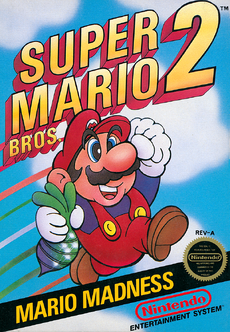 For alternate box art, see the game's gallery. | |||||||||
| Developer | Nintendo EAD | ||||||||
| Publisher | Nintendo | ||||||||
| Platform(s) | Family Computer/Nintendo Entertainment System, Nintendo PlayChoice-10, Virtual Console (Wii, Nintendo 3DS, Wii U), NES Classic Edition/Nintendo Classic Mini: Family Computer, Nintendo Entertainment System - Nintendo Switch Online | ||||||||
| Release date | NES/Famicom: Nintendo PlayChoice-10: Virtual Console (Wii): Virtual Console (3DS): Virtual Console (Wii U): NES Classic Edition: Nintendo Entertainment System - Nintendo Switch Online: | ||||||||
| Language(s) | English (United States) | ||||||||
| Genre | 2D platformer | ||||||||
| Rating(s) |
| ||||||||
| Mode(s) | Single player | ||||||||
| Format | NES:
Wii: Wii U: Nintendo Switch: Nintendo 3DS: NES Classic Edition:
Built-in
| ||||||||
| Input | NES:
Wii: Wii U: Nintendo Switch: Nintendo 3DS: NES Classic Edition:
| ||||||||
Super Mario Bros. 2 is the second game in the Super Mario series outside Japan and the third entry overall.[12] It is a 2D platform game originally released for the Nintendo Entertainment System in North America in 1988. In the years that followed, it has been ported to many other systems, including a release on the Wii's Virtual Console in 2007, the Nintendo 3DS's Virtual Console in 2012, and the Wii U's Virtual Console in 2013. As a result of Japan already having a Super Mario Bros. 2 (known in English as Super Mario Bros.: The Lost Levels and Super Mario Bros. for Super Players), the game did not make its debut in the country until after the release of Super Mario World, on September 14, 1992, making it Japan's fifth installment of the series.
One of the central game mechanics that differentiates Super Mario Bros. 2 from other Super Mario games is that players can select four characters—Mario, Luigi, Toad, or Princess Toadstool—and each of these characters has their unique gameplay mechanics, offering advantages and disadvantages in their stats. Another distinction is that players cannot defeat enemies by stomping on them; players need to either toss items at enemies or pick up and toss enemies at each other to defeat them.
Super Mario Bros. 2 came about after Nintendo of America deemed Super Mario Bros.: The Lost Levels too difficult for Western audiences,[13] which led Nintendo to redevelop the Family Computer Disk System game Yume Kōjō: Doki Doki Panic into a Super Mario Bros. game for the international release. After its release, the game became a commercial success, and eventually the game became well received enough that it was also released in Japan. After performing well both critically and commercially, Super Mario Bros. 2 has been rereleased as one of the four games featured in Super Mario All-Stars, as well as having its own remake in Super Mario Advance. Many enemies introduced in Super Mario Bros. 2 have become common recurring enemies in the Super Mario franchise, such as Bob-ombs, Pokeys, Shy Guys, and more, while the gameplay mechanic of picking up various items and tossing them has been reused in several later games.
Story[edit]
Story from the instruction booklet
One night, Mario had a strange dream. He found himself climbing a long staircase leading up to a mysterious door. Opening the door, Mario's eyes fell upon an incredible world unlike anything he'd ever seen. A quiet voice spoke to Mario, saying,
"Welcome to Subcon, the land of dreams. Our once-beautiful world now suffers at the hands of the evil Wart. Please help us! Only you can free us from his tyranny. Oh, and remember one thing: Wart hates vegetables."
However, before Mario could figure out what was happening, he suddenly awoke on his bed and realized that it was all a dream. The next day, while heading out to a picnic with his friends Luigi, Princess Toadstool, and Toad, Mario told the tale of his strange dream. Hearing this was quite a shock to his friends, who all had the very same dream the night before.
Upon arriving at their picnic spot, the group noticed a small cave. Inside was a long staircase that led up to a door. At the top, the four friends opened the door and stood shocked by what they saw. It was Subcon - the world of their dreams!
Mario discovers that Subcon has been taken over by Wart and that the events of his dream are true. Mario and co. are now on a quest to defeat Wart and restore peace to the dream world. At the end of the game, Mario, Luigi, Toadstool and Toad are seen being chanted on by the inhabitants of Subcon, who are carrying Wart across the room. Mario then wakes up and wonders about whether the events were true or just a dream. He then continues sleeping and the game ends.
In-game story
When Mario opened a door after climbing a long stair in his dream, another world spread before him and he heard a (faint)[14] voice call for help to be freed from a spell.
After awakening, Mario went to a cave nearby and to his surprise he saw exactly what he saw in his dream....
Gameplay[edit]
Since the game is a reskin of Yume Kōjō: Doki Doki Panic, it has little in common with the original Super Mario Bros. For example, in order to defeat enemies, the player needs to pluck clumps of grass to receive items (such as vegetables), and then throw the vegetables at them. It is also possible to defeat enemies by jumping on them, picking them up and then throwing them to other enemies. There are a few elements in common with its predecessor, however, such as the appearances of the Mushroom and Starman, although the former has a different function. If the player has one health point remaining, they turn into their Small form. Additionally, there are no power-ups in the game that grant the player additional abilities in the Super form such as the ability to shoot fireballs, making Super Mario Bros. 2 one of the only 2D Super Mario titles (with the other being Super Mario Run) to not have additional forms after the Super form.
At the beginning of each level, the player can choose between the playable characters: Mario, Luigi, Toad, and Princess Toadstool. All four characters have different powers and statistics. When entering the next level, players can select a different character.
At the end of most levels of the game, the player fights Birdo. The player has to jump on the eggs that it spits, grab them and throw them back, hitting Birdo three times to gain a crystal which opens the Mask Gate at the end of the level. There are several colors of Birdos: pink, which only spits eggs; red, which spits eggs and fireballs and green, which only spits fireballs. For the green Birdos, there are Mushroom Blocks nearby for the player to use instead.
There are seven worlds in this game. The first six has three levels apiece, and the seventh has two. At the end of each world, the player encounters one boss. Mouser is encountered at the end of World 1, Tryclyde in World 2, Mouser again in World 3, Fryguy in World 4, Clawgrip in World 5, Tryclyde again in World 6, and Wart himself at the end of World 7.
Defeated enemies and Birdo can re-spawn if the player runs one screen away from the area where they normally appear and return, which may allow the player to defeat the enemies again in order to regain health if necessary; this still occurs in later releases (except Super Mario Advance), but a defeated Birdo does not reappear unless the player completely leaves and re-enters the areas where Birdo is fought.
Controls[edit]
| Action(s) | NES | Wii Remote | Wii Classic Controller | GameCube Controller | Nintendo 3DS | Wii U GamePad / Pro Controller (Default) | Nintendo Switch Dual Joy-Con / Pro Controller (Default) | Nintendo Switch Single Joy-Con (Default) |
|---|---|---|---|---|---|---|---|---|
| Jump, accept | ||||||||
| Dash, pick up objects, throw objects, pluck vegetables, stop slots at the Bonus Chance | ||||||||
| Pause the game, confirm menu option | ||||||||
| Select option after a Game Over | ||||||||
| Select character, move character | ||||||||
| Enter doors and other openings, climb up vine | ||||||||
| Crouch (Power Squat Jump if held long enough), enter jars, climb down vines |
Characters[edit]
Playable characters[edit]
| Character Name | Mario | Luigi | Toad | Princess Toadstool |
|---|---|---|---|---|
| Artwork | 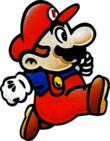
|
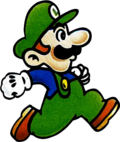
|

|
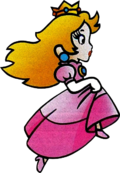
|
| Speed | ★★★★☆ | ★★★☆☆ | ★★★★★ | ★★☆☆☆ |
| Jump | ★★★★☆ | ★★★★★ | ★★☆☆☆ | ★★★☆☆ |
| Strength | ★★★★☆ | ★★★☆☆ | ★★★★★ | ★★☆☆☆ |
| Description | Mario has average stats, making him an acceptable choice in all situations. He has no outstanding abilities. | Luigi has a high jump, but he is weaker than average. He is slightly slower than average as well. | Toad is the fastest and the strongest. He has the lowest jump in the game, however. Due to his poor jumping ability, he relies heavily on the charged jump. | The princess has a special float jump that allows her to hover in midair, which can be used to jump further or correct an otherwise fatal landing. As a tradeoff, she has the lowest speed and power. |
Supporting characters[edit]
| Image | Description |
|---|---|
| Subcon |
The Subcon species are a group of peaceful fairy-like beings that have their land invaded by Wart. Wart traps them in jars, and they plead Mario and his friends for help. They also give Mario and his friends vital information to defeat Wart (namely that Wart hates vegetables). |
| Mask Gate |
Found at the end of each level (or, in boss levels, just before the boss room), Mask Gates will open once the level's Crystal Ball (which is either dropped by Birdo or found out in the open) has been picked up. When entered, the level ends (or, in boss levels, the boss room is entered). |
Enemies[edit]
| Image | Description |
|---|---|
| Albatoss |
Albatosses fly only horizontally. They can drop Bob-Ombs on players, but they can also be ridden. Unlike other enemies, they cannot be picked up, but they are defeated as with any other enemy. |
| Autobomb |
Shyguys often ride Autobombs. Autobombs shoot projectiles, but if the Shyguy is removed, they simply move. Players can ride on Autobombs, but Autobombs must be destroyed with an item. |
| Beezo |
Beezos fly down and attempt to run into the player with their bidents. Players can jump on them and pick them up. |
| Bob-Omb |
Bob-Ombs run back and forth and eventually self-destruct if they are near a player. If they self-destruct, they can harm players. Players can pick them up and throw them. |
| Cobrat |
Cobrats are seen roaming on the ground, but they can also hide in jars. If they spot a player, they may jump and shoot a single projectile. Cobrats can be picked up and thrown. |
| Flurry |
Flurries are found only in ice levels. Here, they attempt to run into the player. They move faster than average, but they are prone to slipping. |
| Hoopster |
Hoopsters crawl slowly on vines or trees aimlessly, occasionally speeding up whenever descending. They harm players if they make contact with them from above or the side. Players can jump on and ride them like an elevator, and even pick them up and throw them. |
| Ninji |
Some Ninjis are stationary enemies that simply jump while others charge and jump into the player. They can be picked up and thrown. |
| Ostro |
Ostros are often seen being ridden by Shyguys. If the Shyguy is removed, they travel in a straight line. They can be picked up and thrown, but they do not bounce off enemies. |
| Panser |
Pansers shoot fireballs at the player. Red varieties are stationary and shoot three fireballs. The green/gray variety patrols and shoot fireballs straight up. Pink varieties chase the player and shoot three fireballs. |
| Phanto |
Phantos are normally dormant enemies, but if players pick up a key, they attempt to fly into the player. If the player drops or uses the key, they deactivate. They cannot be picked up and there are limited methods to destroy them. |
| Pidgit |
Pidgits are always seen on carpets. Pidgits attempt to dive bomb into the player, but players can jump on them, pick them up, and throw them. Once the Pidgit has been removed, players can ride the carpet and control it for a brief amount of time. |
| Pokey |
Pokeys attack players by moving slowly into them. Pokeys can be various heights. They can be defeated by having objects thrown at them or their body segments being removed one by one. |
| Porcupo |
Porcupos cannot be jumped on, so to defeat them, players must throw an object at them. |
| Shyguy |
The basic enemies of the game, Shyguys walk back and forth, harming the player if they run into them. They can be picked up and thrown. Red Shyguys walk off cliffs while pink Shyguys turn at the ledges. |
| Small Fry Guy |
Small versions of Fryguy that bounce in the player's direction. They appear when Fryguy is defeated. They cannot be picked up or thrown, and must have an item thrown at them to be defeated. |
| Snifit |
Snifits shoot projectiles at players, but they act similar to Shyguys. Gray/green Snifits jump and fire projectiles while the other variants walk. The pink Snifit turns around at ledges while a singular red Snifit in World 3-3 walks off ledges. |
| Spark |
Sparks circle around platforms or hover in the air. Sparks can harm the player if they touch them. |
| Trouter |
Trouters jump from below and fall back. Players can use them as platforms to jump across gaps, but Trouters can harm players if players touch them at the sides. |
| Tweeter |
Tweeters, although they have wings, are found hopping across the ground. They can be picked up and thrown. |
| Whale |
Not typical enemies, whales serve generally as platforms. Their bodies and their tails can be jumped on. Their waterspouts can also carry players, but the waterspouts can harm players if players touch them at the sides. |
Mini-bosses[edit]
| Image | Description |
|---|---|
| Birdo |
Birdo is a recurring mini-boss, appearing at the end of every first and second level in the worlds. Birdo comes in three varieties. The pink one shoots simply eggs, which can be picked up and thrown at it. The red one shoots randomly eggs or fireballs (which harms players if they touch them). The remaining type appears green or gray depending on location (but are assigned to the same palette) and shoots only fireballs; these ones must be defeated with Mushroom Blocks. |
Bosses[edit]
| Image | Description |
|---|---|
| Mouser |
Mouser is the first true boss players encounter. He attacks by throwing bombs. The bombs sit for a while before they explode, enabling players to pick them up and throw them at Mouser. If the bomb explodes on Mouser, he takes damage. There are two variants of Mouser: one with pink ears and one with green ears. A white and red variant was replaced by Clawgrip when Yume Kōjō: Doki Doki Panic was remade into Super Mario Bros. 2. |
| Tryclyde |
Tryclyde shoots a series of fireballs that harms the player if the player touches them. Players must throw several Mushroom Blocks at Tryclyde to defeat him. |
| Fryguy |
Fryguy shoots fireballs at players. Players must throw Mushroom Blocks at him to damage him. Once he takes enough damage, he bursts into Small Fry Guys. These take one hit from a Mushroom Block to be defeated, and destroying these enemies clears the level. |
| Clawgrip |
Clawgrip throws rocks at players. These rocks can be picked up and tossed at Clawgrip, inflicting damage on him. Once he is hit five times, he is defeated. |
| Mask Gate |
Although most Mask Gates are harmless and allow completion to the level, the Mask Gate within the dream factory is aggressive, attacking the players by flying into them. Players must attack it with Mushroom Blocks to stun it for a short period. Once it is stunned, it allows entry into Wart's room. |
| Wart |
Wart is the final boss of the game. He moves back and forth and shoots harmful bubbles at the player. A machine nearby spawns vegetables. To defeat Wart, players must throw these vegetables at Wart when Wart's mouth is open. Wart takes six hits to defeat. |
Items and objects[edit]
| Image | Description |
|---|---|
| 1 UP |
When players collect this item, they receive an extra life. |
| Beanstalk, Chain, and Ladder |
Can be climbed to safely reach higher or lower locations. |
| Bomb |
Bombs can be found normally, from plucking vegetables, or from Mouser. They eventually explode, destroying brick walls as well as harming nearby enemies and players. |
| Brick wall |
Brick walls can be destroyed by explosions created by bombs and Bob-ombs, which is often necessary to progress. |
| Cherry |
Found scattered throughout levels, cherries can be collected. If players collect five, a Starman appears. |
| Coin |
Coins are found only in Sub-space. When players pluck vegetables, they receive coins. Coins are used in the Bonus Chance at the end of a level for extra lives. |
| Crystal Ball |
Found at the end of the level or by defeating Birdo, Crystal Balls enable the Mask Gate to open so players can complete the level. |
| Dream Machine |
A machine belonging to the Subcons, which produces the dreams that form the land of Subcon itself. In stealing it, Wart is able to force it into producing minions for his cause. During the battle with Wart, it creates Vegetables, Wart's weakness, for the player to use against him. |
| Egg |
Pink Birdos always spit out eggs, while Red Birdos sometimes spit out eggs (and sometimes spit out fireballs instead). Players can pick these eggs up as they travel through the air, then throw them at Birdo to inflict damage on it. |
| Flying carpet |
After Pidgits are defeated, players can ride and control their Magic Carpets for a short time. |
| Grass |
The player can pull tufts of grass to reveal objects, mainly vegetables. |
| Jar |
Jars, as with Warp Pipes, can be entered by ducking. Jars contain usually some items, including POWs, Turtle Shells, and keys. Jars also contain some enemies, such as Shyguys. |
| Key |
Keys open locked doors, granting access to another part of the level. Phantos guard it, however. |
| Magic Potion |
Found after being plucked, a Magic Potion creates a door depending where the player tosses them. This door leads to Sub-space. |
| Mushroom |
Found only in certain spots of Sub-space, Mushrooms give an extra vitality point once they are picked up. This vitality remains for the rest of the level. The Mushroom also restores any lost health. |
| Mushroom Block |
Mushroom Blocks are simple throwing items. They can be used as weapons or get stacked so players can reach higher places. Mushroom Block designs vary from world to world; the first design is used in Worlds 1 and 3 in all versions (and World 5 in the SNES and GBA versions), the second design is used in Worlds 2 and 6, the third design is used in World 4, the fourth design is used in World 5 exclusively in the NES version, and the fifth design is used in World 7. |
| POW |
POWs can be thrown to create a powerful quake. This quake defeats most enemies in the screen. |
| Rocket |
Rockets are found in grass. If a rocket is found, it automatically transports players to the next part of the level. |
| Small heart |
For every eight enemies defeated, a small heart appears. Small hearts restore any HP a player has lost. If the player is in small form, the heart grows the player to Super form. |
| Starman |
A Starman appears after players collect five cherries. Once players have collected a Starman, they become invincible for a short amount of time, enabling them to defeat most enemies that they touch. |
| Stop Watch |
Found by plucking four vegetables from the grass, then plucking what would otherwise be a fifth, the Stop Watch stops all enemy movements for a brief time. |
| Turtle Shell |
Turtle Shells are found in grass. Once they are thrown, they slide across the ground, defeating any enemy it touches. Once it hits a wall, it is destroyed. If players attempt to land on the shell, they can ride on it. |
| Vegetable |
The basic weapon in the game, vegetables are plucked from grass tufts and can be thrown at enemies to defeat them. Vegetables bounce after they hit an enemy, which can lead to consecutive hits on enemies. If one vegetable defeats enough enemies, extra lives may be rewarded. While unripened vegetables (Sprouts) have no additional effects, plucking four fully ripened vegetables, then going to pluck a fifth, will instead result in the player plucking a Stop Watch. |
Worlds and levels[edit]
Enemies that make their first level appearance are marked with an asterisk.
| World | Terrain | Level | Enemies found |
|---|---|---|---|
| World 1 | 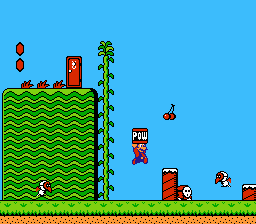 |
1 | |
| 2 | |||
| 3 | |||
| World 2 | 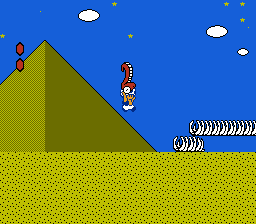 |
1 | |
| 2 | |||
| 3 | |||
| World 3 | 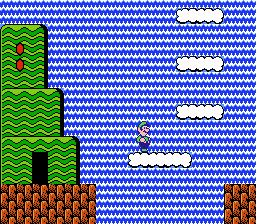 |
1 | |
| 2 | |||
| 3 | |||
| World 4 | 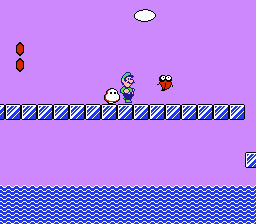 |
1 | |
| 2 | |||
| 3 | |||
| World 5 | 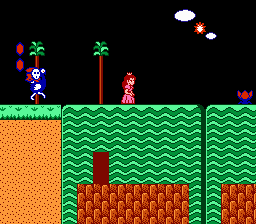 |
1 | |
| 2 | |||
| 3 | |||
| World 6 | 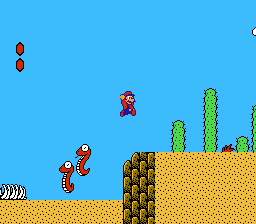 |
1 | |
| 2 | |||
| 3 | |||
| World 7 | 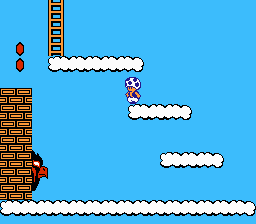 |
1 | |
| 2 |
Development[edit]
Super Mario Bros. 2 started out as a prototype Super Mario-style platform game developed by Kensuke Tanabe, a developer for Nintendo. The prototype game emphasized vertically scrolling levels and throwing blocks. It was originally intended to be a two player co-op game, allowing players to toss each other around. However, the technical limitations of the Nintendo Entertainment System made it difficult to produce a polished game with these elements. It was decided to add more Mario-like elements, such as horizontal levels (although many vertically oriented levels were retained in the final project).[15] Some time later, the Fuji Television Company requested that Nintendo create a video game using Yume Kōjō mascots, and Tanabe developed the prototype into Yume Kōjō: Doki Doki Panic, which became one of the best-selling games for the Family Computer Disk System.
In 1987, Nintendo of America got its first look at the Japanese version of Super Mario Bros. 2. Nintendo of America believed that Super Mario Bros. 2, which was a slightly altered version of the first Super Mario Bros. game with an increased difficulty level, would not be a commercial success in the United States and elsewhere in the world. To deal with this, Nintendo took the finished Yume Kōjō: Doki Doki Panic and reverted the licensing changes to once again feature Mario and his friends as playable characters. The game would later be released in Japan under the name Super Mario USA in 1992.
Many characters and abilities from Super Mario Bros. 2 later reappear in the Super Mario series. Princess Peach's occasional ability to hover in midair and pull vegetables from the ground (Super Smash Bros. Melee), for example, originates from this game. Toad's nimbleness (as seen in the Mario Kart series, where he is a light driver with good acceleration, and from his running speed in Mario Sports Mix) could also have been influenced from his uprooting speed first introduced in Super Mario Bros. 2. Shyguys, Snifits, Bob-Ombs, Pokeys, and Birdo were also introduced and would later be incorporated into later Super Mario games. Some of the enemies (most notably Bob-Ombs and Pokeys) have made countless reappearances as enemies within many of the later Super Mario titles. Wart, the main villain, never reappeared in a Super Mario game after Super Mario Bros. 2, but he appeared in the Nintendo Comics System, and was mentioned in later games. He also appeared as an ally in The Legend of Zelda: Link's Awakening under his Japanese name, "Mamu". The four playable characters return in Super Mario 3D World, where they retain their unique abilities from Super Mario Bros. 2.
Remakes and ports[edit]
- The game was ported to the American arcade machine, the Nintendo PlayChoice-10.
- In Japan, the American Super Mario Bros. 2 was eventually re-released under the name Super Mario USA. It was marketed as the American Super Mario Bros. 2, and the game is unaltered save for the title screen. As such, the ending cast uses the characters' English names (in the manual, their Yume Kōjō: Doki Doki Panic names are also included). Super Mario USA is also the name of the game in the Korean Virtual Console version.[6]
- It was later remastered on the Super Nintendo Entertainment System as a part of Super Mario All-Stars and Super Mario All-Stars + Super Mario World, and it was also included in the Wii re-release of the compilation game, Super Mario All-Stars Limited Edition. The All-Stars version of Super Mario Bros. 2 possessed updated graphics and music.
- The NES version of the game was released on the Wii Virtual Console for 500 points in 2007. It requires 26 blocks (3.3 MB) to be installed.
- The NES version of the game was released for the Wii U Virtual Console in 2013. It requires 13 MB to be installed.
- The game is one of the 30 titles included in the NES Classic Edition and Nintendo Classic Mini: Family Computer.
- The game was made available for the Nintendo Switch Online service on February 13, 2019.
BS Super Mario USA[edit]
- Main article: BS Super Mario USA
BS Super Mario USA is a broadcasted version of the game released on the Satellaview, a Japan-only add-on for the Super Famicom. It is based on the All-Stars version but has an audio drama, a different soundtrack, and many alterations in gameplay. There were four unique broadcasts, each focusing on a different world. Contestants could receive real world prizes after submitting their scores.
Super Mario Advance[edit]
- Main article: Super Mario Advance
The most notable port of Super Mario Bros. 2 is Super Mario Advance for the Game Boy Advance. This port featured the enhanced graphics and sound effects of the All-Stars remaster, as well as voice acting and various other slight changes. It was bundled with an enhanced port of the original Mario Bros. game.
Notable mistakes and errors[edit]
Some errors can be found in the credits of the game:
- Ostro and Birdo have their names swapped.
- Hoopster is spelled "Hoopstar".
- Clawgrip is spelled "Clawglip".
- Tryclyde is spelled "Triclyde".
These errors remain in Super Mario All-Stars. In the Japanese version of Super Mario Advance, the Ostro and Birdo mistake was corrected, and in the International version, the remaining names were corrected to match the manual.
Another mistake which was never fixed for the enhanced ports is the color of the vegetable tufts – in Yume Kōjō: Doki Doki Panic, the grass is consistently black, while in Super Mario Bros. 2 they are red, but keep the black coloring after being picked up. Enhanced ports maintain the red coloring for the tufts, though they turn green when dug out.
Additionally, at least three versions of the North American manual exist. One version provides the full description of Birdo ("Ostro") as "He thinks he is a girl and he spits eggs from his mouth. He'd rather be called "birdetta."[sic],[16] while another version omits the second sentence.[17] The full "Birdetta" version is more true to the original Japanese version, which explains that Birdo, known as "Catherine" in Japan, would rather be called "Cathy."[18] A third version of the manual is known to exist which properly labels Birdo and Ostro,[19] keeps the full Birdo bio,[20] and shows artwork of the unusual pink Beezo as gray and misnamed.[21] This matches its depiction in the game and the Yume Kōjō: Doki Doki Panic manual.[22]
The Super Mario Bros. 2 manual reuses enemy sprites and artwork from the Yume Kōjō: Doki Doki Panic manual (with the notable exception of the Pokey artwork, as well as the omission of a gray Shyguy and addition of Tweeter, Flurry, Spark, and Clawgrip[22]). Thus, it uses the designs of Albatoss and Phanto from Yume Kōjō: Doki Doki Panic.[23]
During the ending celebration sequence, there are common mistakes in the number of levels each hero completes.
Staff[edit]
- Main article: List of Super Mario Bros. 2 staff
A number of people involved in the game include the composer Koji Kondo, known for composing the main Super Mario Bros. theme. Kensuke Tanabe is the director of the game with Shigeru Miyamoto and Hiroshi Yamauchi as producers.
Pre-release and unused content[edit]
In the game's prototype, there is a different color palette for the in-game title, which includes tans and oranges, which contrasts with the final version's reds and blues. Princess Toadstool is shown to have more hair. Characters need to use a Magic Lamp to access Sub-space, similar to Yume Kōjō: Doki Doki Panic. The characters also lack the whites of their eyes and the ability to run.
Glitches[edit]
- Main article: List of Super Mario Bros. 2 glitches
Disappearing Mushroom Blocks[edit]
If the player throws a Mushroom Block offscreen and does not see it land, even to a place where it should safely land, it disappears until the player leaves through a door and comes back.
Lifesaving jar glitch[edit]
This glitch requires precise timing; the character must be small and must enter a jar at the same time they are hit by a Phanto. If this is done correctly, the defeat fanfare plays as usual. However, the character still goes through the jar. When they exit, the character has no health sections left, yet is still alive. This glitch remains in the Super Mario All-Stars enhanced port.
Critical reception[edit]
Super Mario Bros. 2 has been received positively, with IGN editor Lucas Thomas praising the graphics, sound and replay value,[24] although he insisted that Western gamers could have gotten into the Japanese version of the game. GameSpot critic Alex Navarro agreed, and commented that the game "...shows that veering from the beaten path of a franchise's standard game design isn't always a bad idea".[25]
The game placed 47th in the 100th issue of Nintendo Power's "100 best Nintendo games of all time" in 1997.[page number needed] It also placed 81st in the 200th Issue of GameInformer's "Top 200 Games of All Times" and placed 18th on IGN's Top 100 NES Games list.[26]
| Reviews | |||
|---|---|---|---|
| Release | Reviewer, Publication | Score | Comment |
| Wii | Marcel van Duyn, Nintendo Life | 8/10 | "It's a bit of an oddball to players familiar with other Mario games, sure, but the fact that it's so different from the rest of the series is what makes Super Mario Bros. 2 such an entertaining game. If you want a fun but unusual Mario experience, look no further - this is pretty much the textbook definition of it." |
| Wii | Lucas M.Thomas, IGN | 8.5/10 | "American gamers really do have the skill to play the Japanese Super Mario Bros. 2, but it was a good move by Nintendo anyway to create this less frustrating, more funky game; the American Mario 2 is still a lot of fun, and it inspired several aspects of future Super Mario titles. At 500 Wii Points, it's a great value for download. The only reason you may not want to pick it up is if, like Super Mario World, you already own it in another form; this game was re-released with enhanced graphics and a few other bonuses as Super Mario Advance for the launch of the Game Boy Advance back in 2001. As for the "real" Super Mario Bros. 2? Who knows. But the Virtual Console offers Nintendo a great avenue to distribute it here in its original 8-bit form, should the company ever decide we can handle it." |
| Wii | Alex Navarro, GameSpot | 8/10 | "For all its inherent weirdness, SMB2 was, and still is, quite a bit of fun. The level designs are still challenging to navigate, the bosses are still amusing to fight, and the presentation holds up. This is especially true of the music, which is some of the very best of the era. One minute spent in any of the game's subterranean levels is all you need to get that catchy tune stuck in your head for the rest of your natural life. At 500 Wii Points ($5), Super Mario Bros. 2 is a game well worth downloading, both for older audiences who remember playing it back in the day, and younger players interested in a history lesson. Granted, its value is lessened somewhat if you already own the fabulous Super Mario Advance for the GBA, or specifically want to play the Super Mario All-Stars version that came out for the SNES. But, for everyone else, it's a great platformer that shows that veering from the beaten path of a franchise's standard game design isn't always a bad idea." |
| Aggregators | |||
| Compiler | Platform / Score | ||
| GameRankings | 81.25% | ||
Sales[edit]
The game is the fourth best-selling title on the NES, with 10 million copies sold worldwide.
Gallery[edit]
- For this subject's image gallery, see Gallery:Super Mario Bros. 2.
Media[edit]
- For a complete list of media for this subject, see List of Super Mario Bros. 2 media.
References to other games[edit]
- Donkey Kong: Clawgrip tosses rocks in a very similar manner to the way Donkey Kong tossed barrels. In the Super Mario All-Stars and Super Mario Advance versions, some of the indoor areas look like warehouses with familiar-looking girders in the background.
- Donkey Kong Jr.: Sparks reappear in Super Mario Bros. 2. This makes them the only returning enemies to appear.
- Mario Bros.: POW Blocks appear as usable items.
- Super Mario Bros.: The Starman power-up appears in the game, as well as a remix of the Ground Theme from Super Mario Bros. played in Sub-space. Also, the heroes shrink once they are down to one heart point. Also, the ability to run by holding down the
button is exclusive to the Super Mario franchise, and was not present in Doki Doki Panic. The title theme is a rearrangement of the Underwater Theme from this game. Mario's artwork on the international box art is a flipped and modified version of his artwork from this game.
- The Legend of Zelda: The sound effect of Birdo spitting an egg is taken from the sound effect that plays when a magic projectile is fired from Link holding the Fire Rod or from a Wizzrobe.
- Super Mario Bros.: The Lost Levels: Luigi being a higher jumper than Mario is re-established when he replaced Mama in the game.
References in later media[edit]
- Super Mario Bros. 3: Bob-ombs return here and act similarly as in Super Mario Bros. 2. Also, Mario can pick up shells or Ice Blocks to throw them. Desert, sky, and snow themes of levels and doors returned. Players can earn lives via the Spade Panel slot minigame. Peach's sprite is also reused here.
- Super Mario Advance 4: Super Mario Bros. 3: Vegetables (which can also be added to the main game via the Blue Green Switch), soft sand that can be dug through, Porcupos, Flurries, Hoopsters, and locked doors return in this game's World-e levels.
- The Super Mario Bros. Super Show!: Super Mario Bros. 2 is represented heavily in this show along with the original Super Mario Bros. Nearly all of the characters (notably excepting Wart and Pansers) and game play props appeared in the stories, and are often more prominent than the original game's features.
- Super Mario World: Pokeys, Ninjis, and Pidgits first reappear here.
- Wario's Woods: Toad's strength returns in this game, and he picks up, carries, and throws Bombs and his enemies as he did in Super Mario Bros. 2. Some enemies (such as the Spud) also vaguely resemble the vegetables from Super Mario Bros. 2. Birdo also makes her first reappearance in the Super Mario franchise through this game.
- Super Smash Bros. Melee: A Super Mario Bros. 2-themed stage called Mushroom Kingdom II is selectable, and Birdo frequently appears at the sides of the stage, spitting eggs at fighters. This stage also plays Super Mario Bros. 2's Ground Theme, as well as that game's boss music (during Sudden Death matches). Also, parts of Princess Peach's moveset (floating and picking vegetables) come from Super Mario Bros. 2. There are also trophies of Birdo, Pidgit, and the vegetables.
- Super Mario 64 DS: Luigi's scuttle jump appears to have been influenced by his jumping style from Super Mario Bros. 2.
- Mario & Luigi: Partners in Time: Pidgits reappear and they attack as they do in Super Mario Bros. 2.
- Super Princess Peach: The ability to pick up enemies and throw them at each other to defeat them is reused in this game, although it is not the only way Peach can defeat enemies as she can also attack enemies with Perry.
- Mario Hoops 3-on-3: The final victory theme is a rearrangement of the ending theme of Super Mario Bros. 2.
- Super Paper Mario: Francis mentioned having a comic called, "Cyborg Wart", which is clearly a reference to Wart. Also, there were Sammer Guys by the names of "Squatting Birdo", "Pidget on Wind's Breath", "Sleeping Turnip", "Upward Leaping Ninji", "Plugged Snifit", and "Guy Who Fry", references to Birdo, Pidgit, Turnip, Ninji, Snifit, and Fryguy, respectively.
- Super Smash Bros. Brawl: Peach retains her moveset from Melee, and there's another trophy of Birdo. Also, Wart and Birdo's names appear in the random name selection. Finally, Super Mario Bros. 2 is available as a Masterpiece to play. The character the trial starts out with is Peach (but it is possible to play as another character if one gets a Game Over before the trial ends). Snifit and Mouser appear as stickers. To unlock it, one must win five brawls with Peach.
- Mario & Luigi: Bowser's Inside Story: In this game, Wiggler sometimes attack by pulling out vegetables, which are the same ones that are seen in Super Mario Bros. 2. Also, one of Bowser's brainwashed minions states that he forgot what Bowser's Castle was originally called (before it was turned into "Fawful Theater"), and mistakenly referred to it as "Mouser's Castle".
- New Super Mario Bros. Wii: The way the characters are able to pick up the items, such as the POW Block, returns.
- Super Mario Galaxy 2: Luigi's Triple Jump may be based on his jumps from Super Mario Bros. 2.
- Mario vs. Donkey Kong: Mini-Land Mayhem!: Arrangements of the Ground Theme, life lost, boss battle, and victory themes are heard in World 1.
- Mario Sports Mix: Toad's throwing animations appear to be influenced from Super Mario Bros. 2, and his high running speed returns.
- Super Mario 3D Land: Mario and Luigi's chargeable jumps while crouching resemble the Power Squat Jump ability that the playable characters can perform in Super Mario Bros. 2 while crouching.
- Mario Kart 7: The Shy Guy Bazaar course makes references to the elements from Super Mario Bros. 2 such as the addition of magic carpets and jars in their original color schemes. The namesake Shy Guys also appear to be the dominant audience members throughout the course.
- New Super Mario Bros. 2: The Cannon levels resemble Sub-space.
- Paper Mario: Sticker Star: Pokeys based on their appearance in Super Mario Bros. 2 return. Also, the main theme is a jazzy version of the credits theme from this game. Ninjis reappear as enemies.
- Super Mario 3D World: Princess Peach and Toad are once again playable characters, and everybody has the same abilities as in Super Mario Bros. 2. An arrangement of Super Mario Bros. 2's "character select" music is used for the Lucky House.
- Super Mario 3D World + Bowser's Fury: A portion of the music of Scamper Shores references the start of Super Mario Bros. 2's Ground Theme.
- Donkey Kong Country: Tropical Freeze: The ability to pluck items out of the ground (using Item Handles) and the ability to carry specific enemies were brought over from Super Mario Bros. 2, according to Kensuke Tanabe.[27]
- NES Remix 2 / Ultimate NES Remix: Several challenges are based on this game.
- Super Smash Bros. for Nintendo 3DS / Wii U: Grass appears as an item in these games. Peach's Vegetable move and floating ability returns, this time with the vegetable-pick sound effect taken directly from the NES version of the game. Also, Luigi performs a scuttle in his jump, a technique that originated in this game. The Ground Theme is present in Super Smash Bros. for Wii U and can be heard on the stages Peach's Castle (64) and Super Mario Maker.
- Captain Toad: Treasure Tracker: Turnips return, alongside various roof structures that resemble Wart's castle.
- Mario vs. Donkey Kong: Tipping Stars: New arrangements of the Ground Theme, world clear, and life lost themes appear in Rolling Hills.
- Super Mario Maker / Super Mario Maker for Nintendo 3DS: The door sprite from Super Mario Bros. 2 is used in the Super Mario Bros. 3 game style in these two games. Shy Guy's sprite is reused for his costume, and sound effects from Super Mario Bros. 2 can be heard in the costumes for Peach, Shy Guy, and Birdo. A course based on World 1-1 also appeared as an Event Course on December 2015.
- Mini Mario & Friends: amiibo Challenge: The abilities for Mini Luigi and Mini Peach work similar to their counterparts in this game. The arrangements from Mario vs. Donkey Kong: Tipping Stars are reused in Boost Pad Bonanza.
- Paper Mario: Color Splash: Shy Guys are the most common enemy in this game. An arrangement of the Ground Theme from Super Mario Bros. 2 is used in the Spinning-Door bonus areas. Jars make an appearance in Château Chanterelle. Wart is mentioned by a yellow Toad.
- Super Mario Run: Ninjis return in this game, retaining their colors from Super Mario Bros. 2 and look from Super Mario Advance artwork. An arranged version of the underground theme from Super Mario Bros. 2 is featured in the background music for Remix 10. This is also Peach's first playable appearance in a 2D Super Mario platformer since Super Mario Bros. 2, although the player has to rescue her in order to play as her as she is also the usual damsel in distress in this game. As in her playable appearance in Super Mario 3D World, Peach also retains her ability to float from Super Mario Bros. 2 along with the addition of slowly descending in mid-air.
- Super Mario Odyssey: Mario can carry and throw Turnips, as in Super Mario Bros. 2.
- Super Mario Party: Shy Guy's sprite appears in Puzzle Hustle.
- Super Smash Bros. Ultimate: Peach (and by extension, her new Echo Fighter Daisy) returns her float and vegetable moves from the previous games. Mushroom Kingdom II from Super Smash Bros. Melee returns with updated graphics based on Super Mario All-Stars and various spirits originating Super Mario Bros. 2 also appear. A new arrangement of the Ground Theme is also featured.
- Super Mario Maker 2: The SMB2 Mushroom was added in the version 3.0.0 update and grants the player Mario's abilities in Super Mario Bros. 2. The 3.0.0 update also added the Cursed Key, which summons Phanto once it is collected.
- Mario Kart Tour: The Shy Guy Bazaar course from Mario Kart 7 returns as a classic course in Mario Kart Tour. The special skill of Birdo (Green) is the Fire Flower, referencing Green Birdo's ability to shoot fireballs in Super Mario Bros. 2.
- Super Mario Bros. Wonder: The Power Squat Jump move reappears as the Crouching High Jump badge, and Luigi's high jump and Scuttle return as the Floating High Jump badge. Peach's Floating Jump returns as another badge.
Quotes[edit]
- "Uprooting and lifting things as you played gave the game a new feel. It was released in Japan as Super Mario USA." — Shigeru Miyamoto, Super Mario History 1985-2010 Booklet
- "The basic controls have a very free, silly feeling to them that I absolutely love." — Takashi Tezuka, Super Mario History 1985-2010 Booklet
- "I adjusted the sounds of the NES to make it sound like a lot of different instruments were being played." — Koji Kondo, Super Mario History 1985-2010 Booklet
Names in other languages[edit]
| Language | Name | Meaning |
|---|---|---|
| Japanese | スーパーマリオUSA Sūpā Mario Yū Esu Ē |
Super Mario USA |
| Chinese (simplified) | 超级马力欧USA Chāojí Mǎlì'ōu USA |
Super Mario USA |
| Chinese (traditional) | 超級瑪利歐USA Chāojí Mǎlì'ōu USA |
Super Mario USA |
| Korean | 슈퍼 마리오 브라더스 2 Syupeo Malio Beuladeoseu 2 슈퍼 마리오 USA[28] Syupeo Malio USA |
Super Mario Bros. 2 Super Mario USA |
See also[edit]
Trivia[edit]
- The South Korean Virtual Console release on Wii is the Japanese version, whereas the South Korean release on Nintendo 3DS uses the international version.
- If the player defeats Wart with Luigi, he does one jump in the ending cutscene instead of two.
- On the Nintendo Entertainment System / Famicom, all sprites are limited to three colors per sprite. Despite this, Mario, Luigi and Princess Toadstool have white in their eyes along with three additional colors. This effect is achieved by a white rectangle hidden behind the character's sprite, while the eyes are transparent. This is part of the reason why their eyes flicker when entering a door or overlapping with another sprite.[29]
- Despite the fact that some artwork still depicts Mario and Luigi with blue shirts, and red and green overalls respectively, the sprites swap the shirts' and overalls' colorization. This change was later officialized in Super Mario Bros. 3.
External links[edit]
References[edit]
- ^ Nintendo Power Pak Source. Nintendo of America (American English). Page 20.
- ^ NES Games (PDF). Nintendo of America (American English). Archived September 21, 2008, 01:55:24 UTC from the original via Wayback Machine. Retrieved June 5, 2024.
- ^ Super Mario Bros. 2 (Video Game 1988) - Release info. IMDb (English). Retrieved June 5, 2024.[better source needed]
- ^ (October 19, 2015). Super Mario Bros. Hyakka: Nintendo Kōshiki Guidebook, Super Mario USA section. Shogakukan (Japanese). ISBN 978-4-09-106569-8. Page 64.
- ^ Super Mario Bros. 2 (VC). The Mushroom Kingdom. Retrieved June 5, 2024.
- ^ a b Wii. Nintendo Korea (Korean). Archived December 5, 2008, 12:09:42 UTC from the original via Wayback Machine. Retrieved June 5, 2024.
- ^ スーパーマリオUSA. Nintendo (Japanese). Retrieved June 5, 2024.
- ^ Nintendo (February 5, 2019). ファミリーコンピュータ Nintendo Switch Online 追加タイトル [2019年2月]. YouTube (Japanese). Retrieved June 5, 2024.
- ^ Nintendo of America (February 5, 2019). Nintendo Entertainment System - February Game Updates - Nintendo Switch Online. YouTube. Retrieved June 5, 2024.
- ^ Nintendo of Europe. #SuperMario Bros. 2 and #Kirby’s Adventure are coming to #NintendoSwitchOnline – Nintendo Entertainment System on 13/02! #NES. X. Retrieved June 5, 2024.
- ^ (February 13, 2019). New #NES games have been added to #NintendoSwitchOnline – Nintendo Entertainment System! Save the world of Subcon in #SuperMario Bros. 2, and use your enemies’ powers against them in #Kirby’s Adventure!. X (Australian English). Retrieved June 5, 2024.
- ^ Kazuya Sakai (Ambit), kikai, Akinori Sao, Junko Fukuda, Kunio Takayama, and Ko Nakahara (Shogakukan) (ed.) (2018). Encyclopedia Super Mario Bros.. Milwaulkie: Dark Horse Books. ISBN 978-4-09-106569-8.
- ^ McLaughlin, Rus (September 13, 2010). IGN Presents: The History of Super Mario Bros.. IGN. Retrieved June 5, 2024.
- ^ Super Mario Bros. 2 Prototype. The Mushroom Kingdom (English). Retrieved June 5, 2024.
- ^ Kohler, Chris (April 1, 2011). The Secret History of Super Mario Bros. 2. Wired (English). Retrieved June 5, 2024.
- ^ Nintendo (1988). Super Mario Bros. 2 instruction booklet (PDF). Nintendo of America (American English).[page number needed]
- ^ Nintendo. Super Mario Bros. 2 instruction booklet (later edition) (PDF). Nintendo of America (American English).
- ^ The Mushroom Kingdom provides the original Japanese biography of Birdo/Catherine. The Mushroom Kingdom (English). Retrieved June 5, 2024.
- ^ The manual for Super Mario Bros. 2. NintendoAge (English). Page 25-26. Archived March 5, 2016, 09:29:49 UTC from the original via Wayback Machine. Retrieved June 5, 2024.
- ^ The manual for Super Mario Bros. 2. NintendoAge (English). Page 27-28. Archived May 28, 2019, 20:28:44 UTC from the original via Wayback Machine. Retrieved June 5, 2024.
- ^ Super Mario Bros. 2 instruction booklet. nintendoage.com. Page 23-24. Retrieved June 5, 2024.[dead link]
- ^ a b (December 21, 2013). The Happiest Arabian Family in Video Game-dom. Back of the Cereal Box (English). Retrieved June 5, 2024.
- ^ Nintendo (1988). Super Mario Bros. 2 instruction booklet. Nintendo of America (American English). Page 24-25.
- ^ Thomas, Lucas M. (July 5, 2007). Super Mario Bros. 2 Review. IGN (English). Retrieved June 5, 2024.
- ^ Navarro, Alex (July 5, 2007). Super Mario Bros. 2 Review. GameSpot (English). Retrieved June 5, 2024.
- ^ 18. Super Mario Bros. 2. IGN (English). Retrieved June 5, 2024.
- ^ Nintendo of America (June 11, 2013). Wii U Developer Direct - Donkey Kong Country: Tropical Freeze @E3 2013. YouTube (American English). Retrieved June 5, 2024.
- ^ From the Korean version of Super Smash Bros. Ultimate.
- ^ Retro Game Mechanics Explained (November 3, 2020). 5 Colors in One Sprite Explained - Audiovisual Effects Pt. 04. YouTube. Retrieved October 26, 2022.
